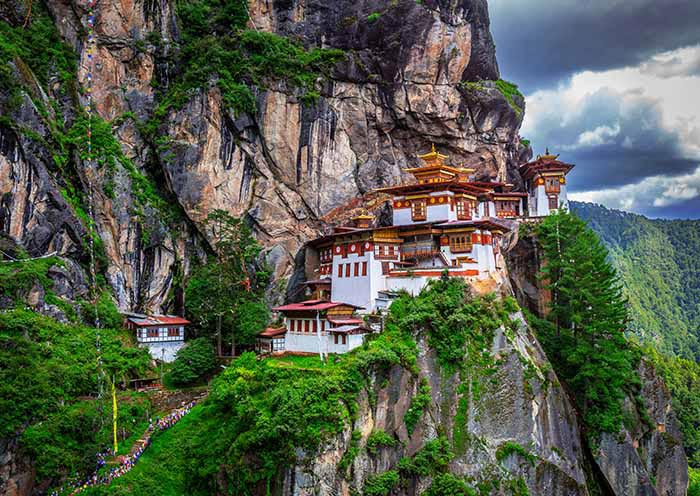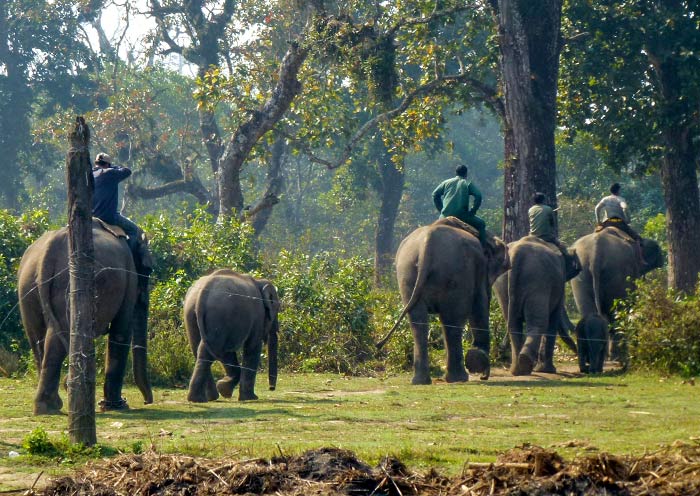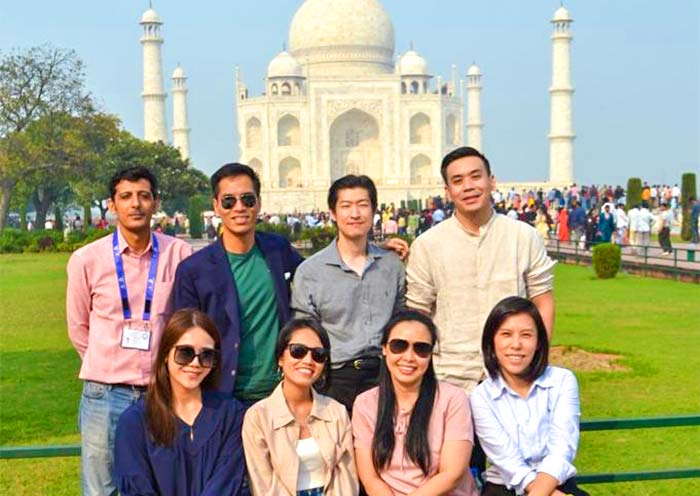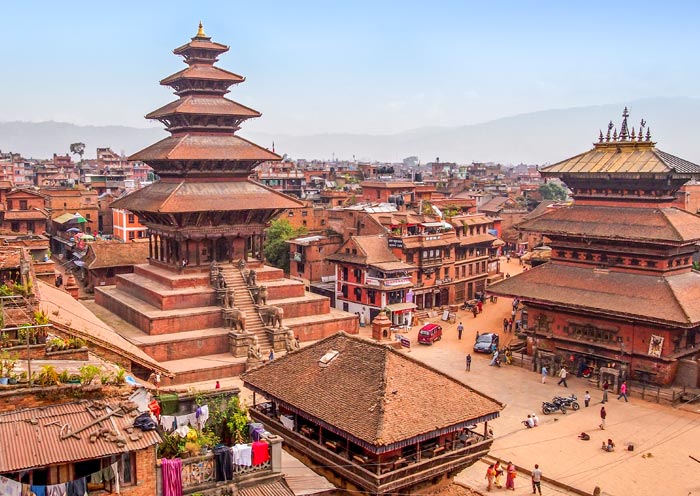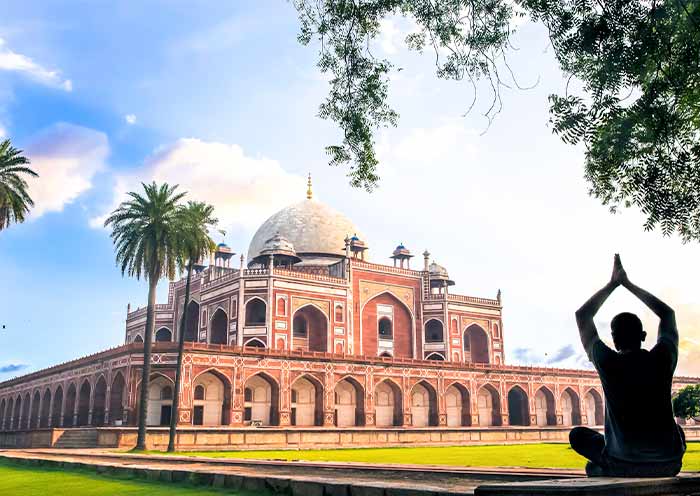- Highlights
- Itinerary
- Price
- Trip Notes
- Accommodation
- Photos
- Reviews
Want to explore the mysterious Himalayan countries like India and Bhutan? What are the must-visit cities of India? India’s Golden Triangle - Delhi, Agra & Jaipur. What are the must-visit cities of Bhutan? Bhutan’s Top 3 Tourist Cities - Paro, Thimphu & Punakha. Take our 12 Days India Bhutan Tour and Explore 2 Mystery Countries Hidden in the Himalayas. This tour offers you rich cultural experiences in both Incredible India (Hinduism country) & Mystery Bhutan (Buddhist country).
Start your India Tour in the Golden Triangle by visiting seven UNESCO World Heritage sites, such as Qutub Minar, Humayun's Tomb, the Red Fort (optional), the Taj Mahal, Agra Fort, Fatehpur Sikri, and Jaipur's Jantar Mantar. Through its rich history, vibrant culture, and architectural marvels, you will discover why India is famed as Incredible.
Then, escape from the hustle and bustle of India and find peace with a Bhutan Tour. You will visit Bhutan's top three popular tourist cities and explore their top attractions, including Tiger's Nest, Kyichu Lhakhang, Buddha Dordenma Statue, National Memorial Chorten, Tashichho Dzong, Dochula Pass, Chimi Lhakhang, and Punakha Dzong. Discover why Mystery Bhutan is famed as a Happy Kingdom.
Contact us now to book your 12-Day India Bhutan Tour at an affordable price and experience high-quality service! Spend your vacation exploring two hidden gems in the Himalayas for an unforgettable journey.
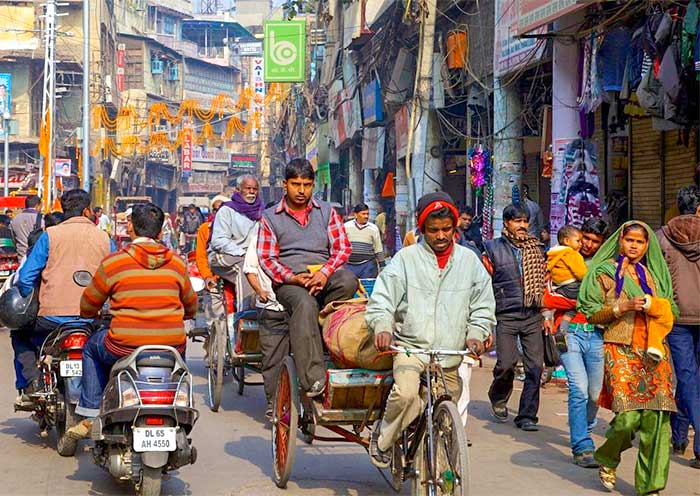
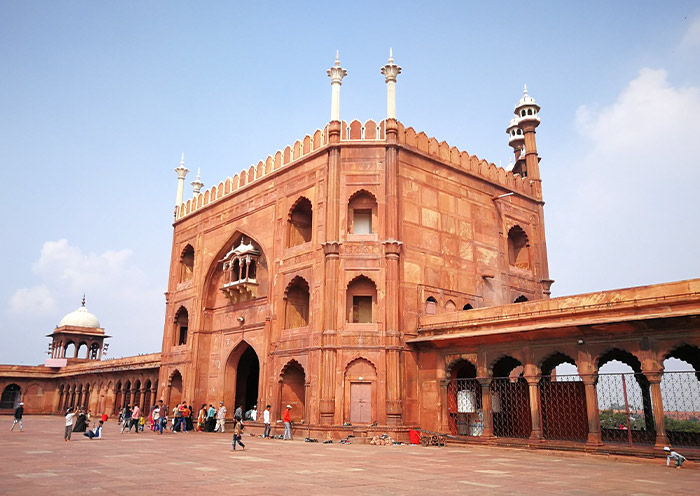
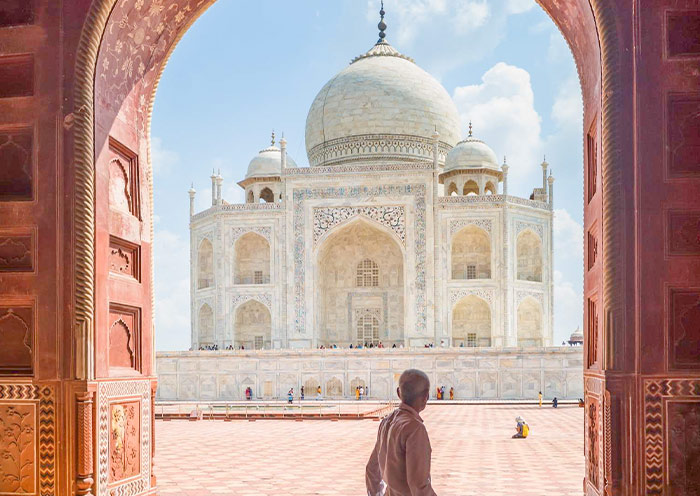
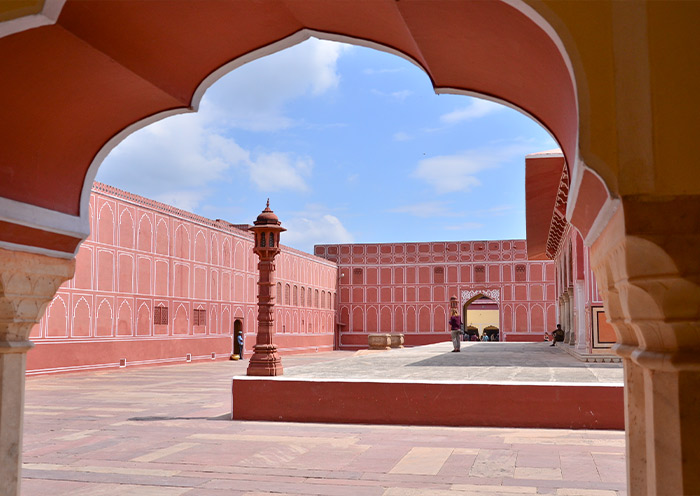
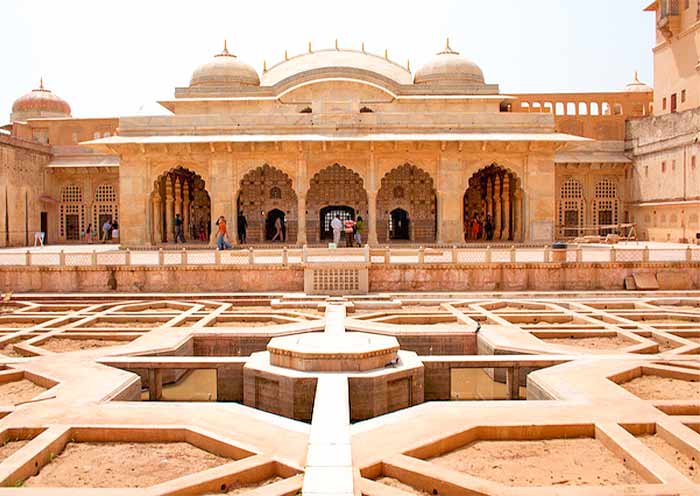
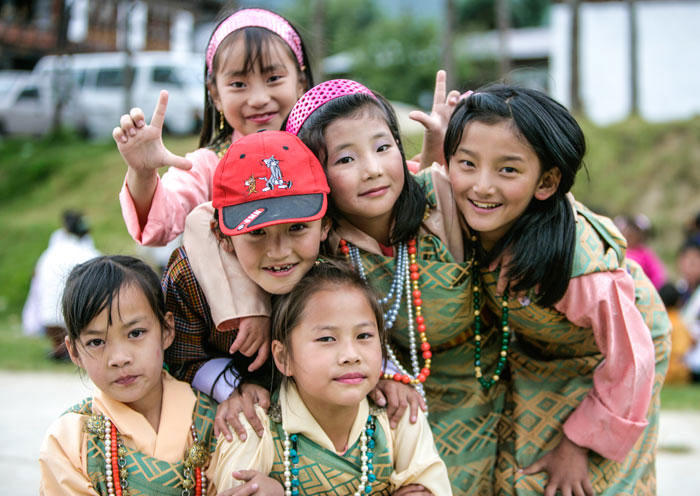
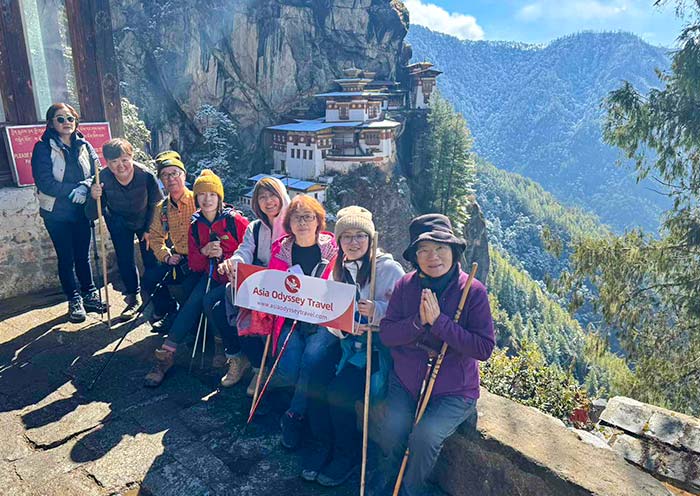
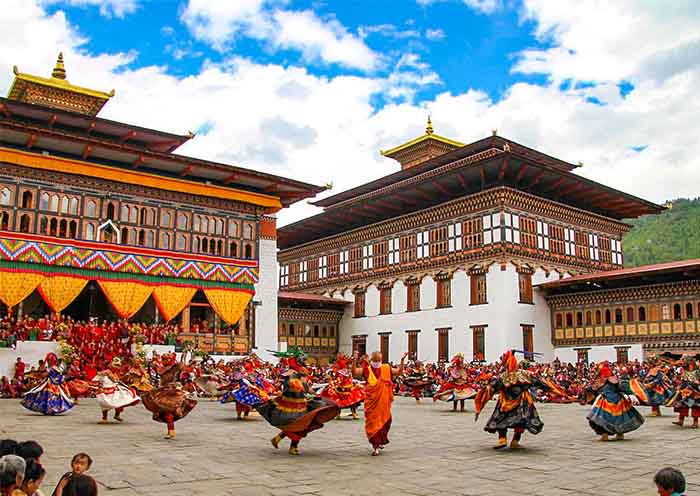
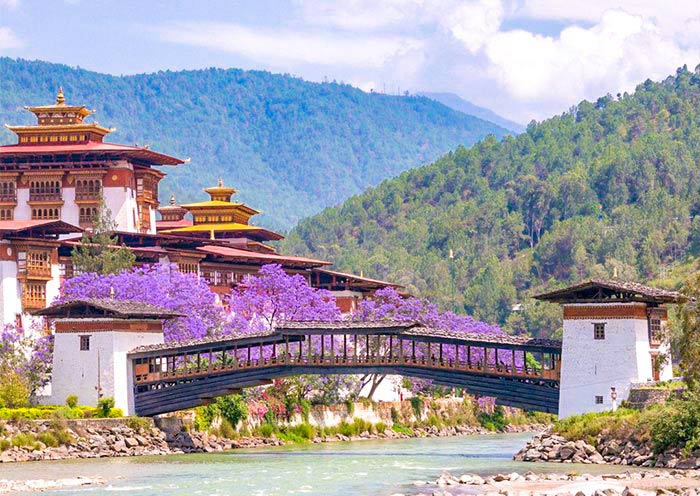
Itinerary at a Glance
Delhi (2 Days)
Jama Masjid, Qutab Minar (World Heritage), Humayun's Tomb (World Heritage), Jantar Mantar, Red Fort (optional, World Heritage)
Agra (2 Days)
Mehtab Bagh,Taj Mahal (World Heritage), Agra Fort (World Heritage), Itmad-ud-Daula's Tomb, Fatehpur Sikri (World Heritage)
Jaipur (2 Days)
Amer Fort, Sheesh Mahal, Jaipur Jantar Mantar (World Heritage)
Delhi (1 Day)
Delhi Transfer
Paro (2 Days)
Tiger's Nest Monastery (Taktsang Goemba, Takhtsang Lhakhang, Paro Taktshang), Drukgyel Dzong, Kyichu Lhakhang, Farmhouse Visit, Tamchog Lhakhang, Paro Airport Birds Eye View Point, Bhutan National Dress Experience, Rinpung Dzong, National Museum, Paro Local Market (If time permits)
Thimphu (1 Day)
Buddha Dordenma Statue, National Memorial Chorten, Tashichho Dzong (Thimphu Dzong), Motithang Takin Preserve (If time permits), Folk Heritage Museum Dinner (optional), Zilukha Nunnery (If time permits), Thimphu Weekend Market (If time permits), Craft Bazaar
Punakha (2 Days)
Dochula Pass, Chimi Lhakhang, Punakha Dong, Punakha Suspension Bridge, Khamsum Yulley Namgyal Chorten
Itinerary Day by Day
Welcome to Delhi, the capital city of India! When you arrive at Indira Gandhi International Airport, our local professional guide and driver will pick you up and escort you to the downtown area. After checking in at your hotel, you can relax and decompress from your long flight for the rest of the day.
Delhi is a fascinating metropolis that seamlessly blends the old with the new. Divided into two distinct parts - Old Delhi and New Delhi - the city offers a captivating journey through time, where ancient traditions coexist with modern developments.
Arrival Ideas:
1. Flights to Delhi: Travelers can take international flights to Indira Gandhi International Airport from major cities in Europe (London, Paris, Frankfurt, Amsterdam, Rome), the Middle East (Dubai, Doha, Abu Dhabi), North America (New York, Toronto, Los Angeles), and Asia (Kathmandu, Singapore, Phuket, Istanbul, Kuala Lumpur, Kuwait, Bangkok, Colombo). India domestic flights connect New Delhi with Varanasi (1h 20m), Udaipur (1h 25m), Mumbai (2h), Amritsar (1h 20m), and other destinations.
2. Delhi Airport Transportation: Delhi Airport is located in Palam, about 18km southwest of central Delhi. The airport is well-connected to the city center, with a typical travel time of 30 to 45 minutes by car.
Free Time Ideas (Optional): Red Fort Sound and Light Show (Jai Hind, Evening Show of 60 min)
With a seating arrangement of 700 people for a single viewing, this spectacular evening show brings the history of the Red Fort (World Heritage) and Delhi to life in a fun and engaging way! (Tips: Closed on Mondays. Make sure to book your tickets in advance. Show timings: 6:30 - 7:30 pm in Hindi; 8:15 - 9:15 pm in English).
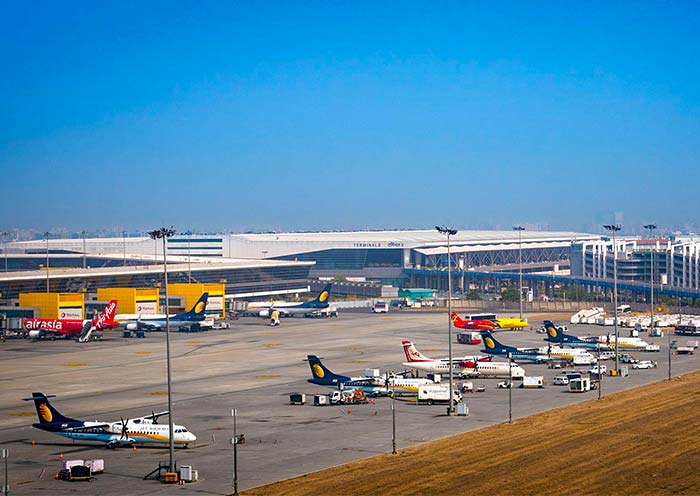
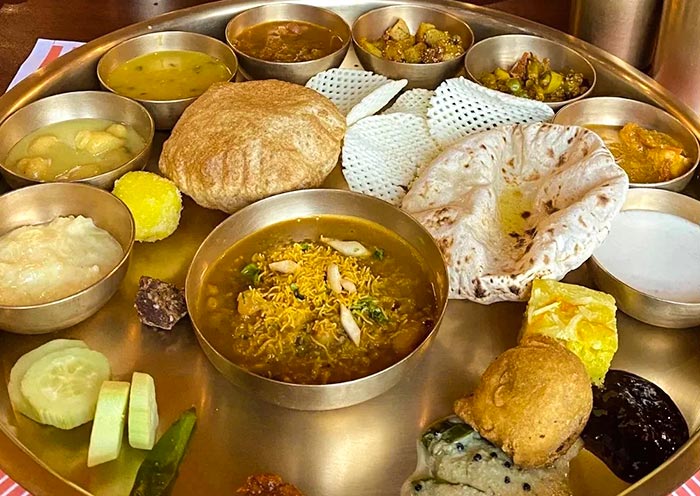
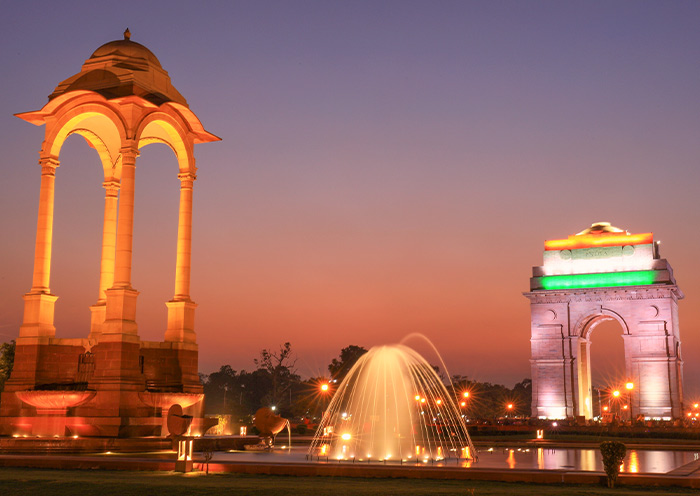
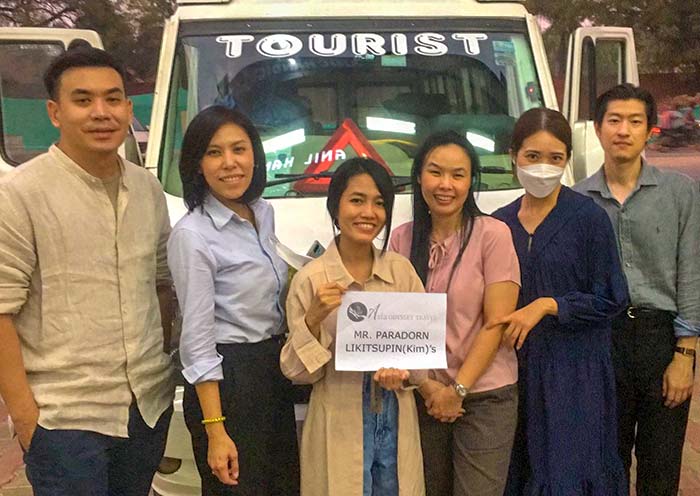
Get ready for an extraordinary adventure in Delhi! Today, you’ll embark on a unique time travel tour, journeying from the majestic Old Delhi steeped in history, all the way to the modern marvels of New Delhi. This exciting exploration will weave together the vibrant tapestry of Delhi, allowing you to witness the city's ancient grandeur seamlessly blend with its contemporary flair.
Your exploration begins in the heart of Old Delhi, where you'll visit Jama Masjid, one of India's largest and most awe-inspiring mosques. Construction began in 1644 under the reign of the Mughal emperor Shah Jahan, the same visionary who brought us the Taj Mahal. This magnificent structure, also known as Masjid-i-Jahan Numa (meaning "mosque commanding the view of the world"), is crafted from red sandstone and adorned with beautiful white marble. Step back into the 17th century and stand in awe under the towering minarets of Jama Masjid. Feel the spiritual energy resonate through time and imagine the grandeur of the Mughal era as the call to prayer echoes through the centuries.
Later, take a stroll to Chandni Chowk, one of the oldest and busiest markets in Old Delhi. Also established by the Shah Jahan in the 17th century, this market is a maze of narrow alleyways filled with small shops offering delectable snacks, sweets, and savories, as well as budget-friendly deals on clothing and other items. Chandni Chowk stretches from the iconic Red Fort to the historic Fatehpuri Masjid, covering a significant distance. To fully immerse yourself in the charm of Old Delhi, we recommend taking an optional rickshaw tour around Chandni Chowk.
Don't miss the opportunity to pass by the Red Fort (World Heritage) and marvel at its symbol of grandeur. Known as Lal Qila and built by the Shah Jahan, the fort serves as the main residence for the Mughal emperors of India and is recognized as a significant architectural masterpiece.
After that, make your way to New Delhi and explore the iconic India Gate. This magnificent memorial is dedicated to the Indian soldiers of World War I. Resembling the Arc de Triomphe in Paris, India Gate stands as a prominent landmark, symbolizing an important chapter in India's history.
As you move forward, you'll have the opportunity to witness the transformation of Delhi into a thriving modern metropolis while also having a chance to take photos of several notable landmarks, including the Rashtrapati Bhavan (Presidential Residence), Parliament House, North Block, and South Block.
Then, you will arrive at Qutub Minar, a UNESCO World Heritage Site and the tallest brick minaret in the world. Standing proudly at an astonishing height of 72.5 meters (238 feet), the Qutub Minar showcases the exquisite craftsmanship of Indo-Islamic architecture. Prepare to be enthralled by the sheer magnificence of this historical masterpiece as you delve into its rich and fascinating history that dates back to the 12th century.
Finally, visit Humayun's Tomb, another jewel in Delhi's crown and a UNESCO World Heritage Site. It holds the distinction of being the first significant example of a Mughal garden tomb. Its breathtaking design and captivating blend of Persian and Indian architectural styles even served as inspiration for the future wonder of the world, the Taj Mahal! Adorned with intricate marble inlays and surrounded by Char Bagh gardens, this red sandstone monument stands as an iconic symbol of Mughal architecture. Stroll through the paradise garden, marvel at the architectural grandeur, and immerse yourself in the captivating love story it holds.
After this amazing tour, you’ll head back your hotel.
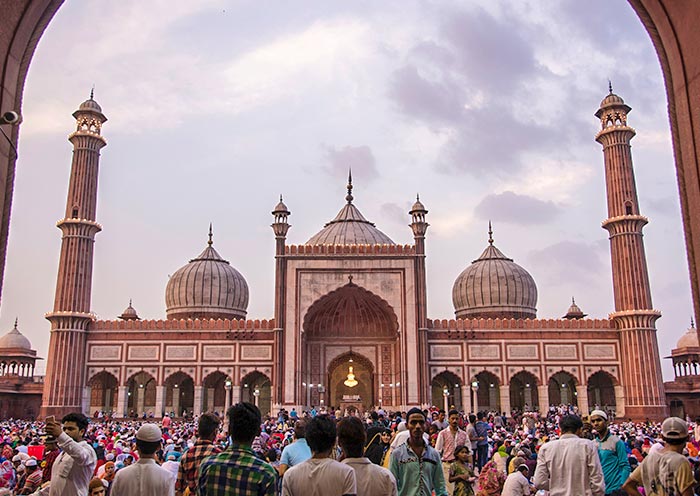
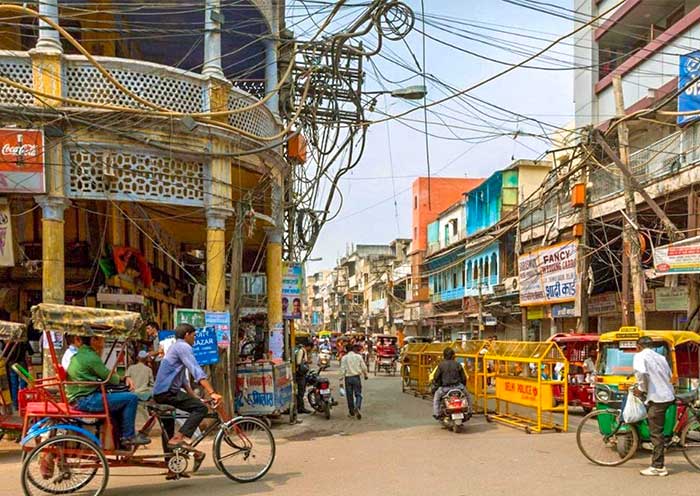
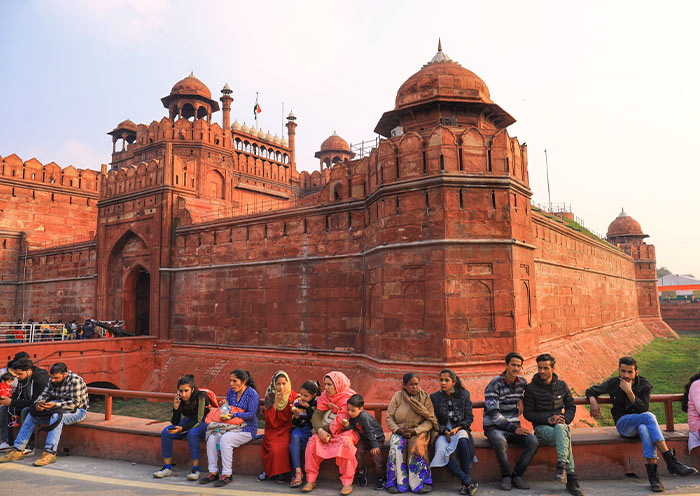
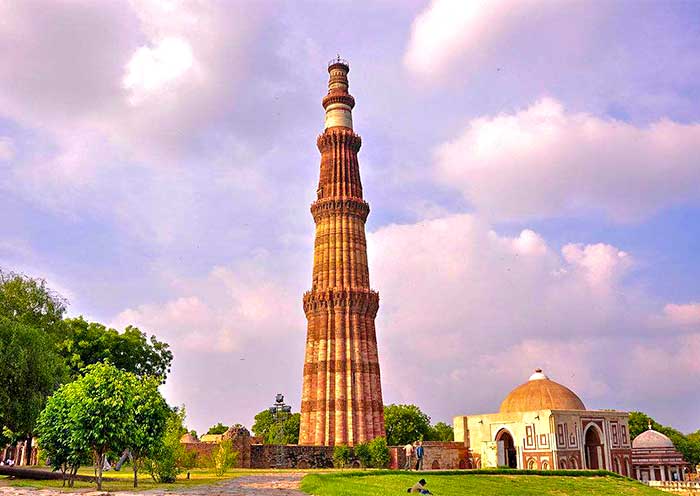
Start your day with a tasty breakfast at your hotel in Delhi and bid farewell to the capital of India in the morning. Head off to Agra, a journey of approximately 250km (155miles) that takes about 4.5 hours, depending on traffic conditions.
The primary route for travel between Delhi and Agra is the Yamuna Expressway. It is known for its well-maintained surface and infrastructure. With our selected vehicle, that's a comfy road trip guaranteed. And it's a scenic road trip as well! Witness the captivating transformation as Delhi's urban sprawl transitions into picturesque landscapes, flyover bridges right over lush green fields, and vibrant agricultural farms painting the landscape. So don't hesitate to ask for a pit stop to capture the essence of the journey with your camera!
Upon arrival in Agra, you can visit Mehtab Bagh for an amazing sunset view. Known as the "Moonlight Garden", Mehtab Bagh is a 16th-century Mughal-era garden that offers a unique perspective of the Taj Mahal, especially during sunset. Watch the iconic Taj Mahal's silhouette reflecting over the calm Yamuna River, creating a truly magical scene. It's a perfect sneak peek preview of the Taj Mahal.
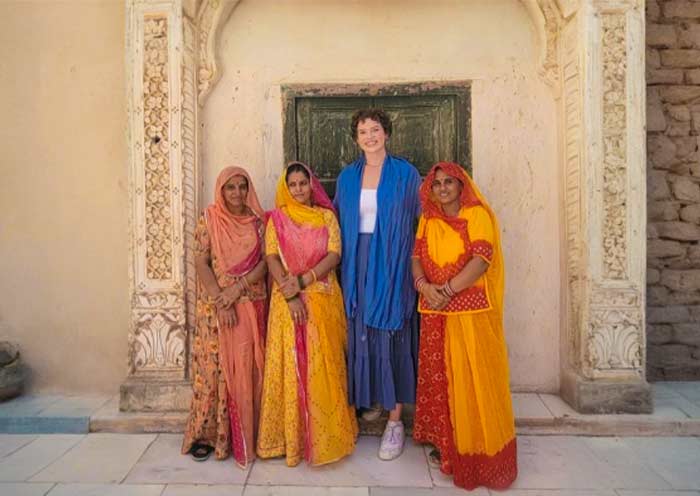
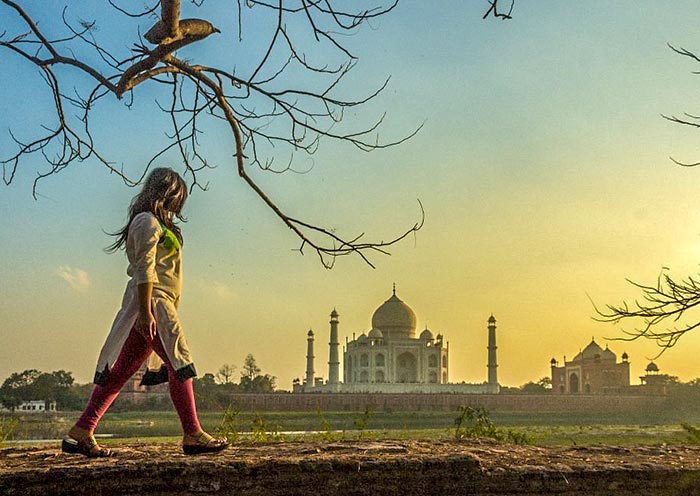
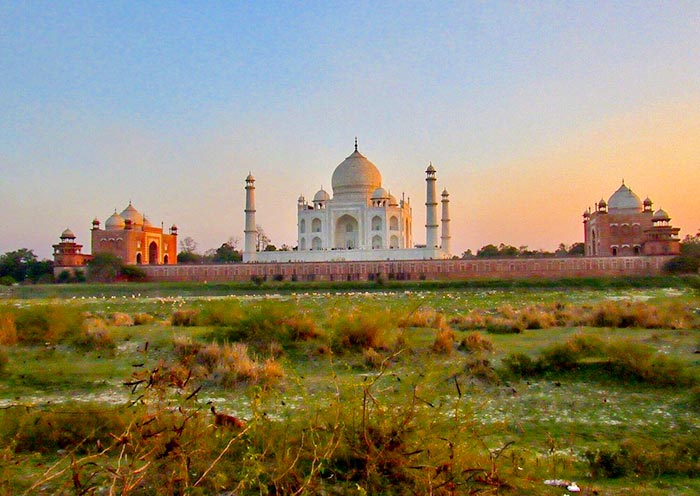
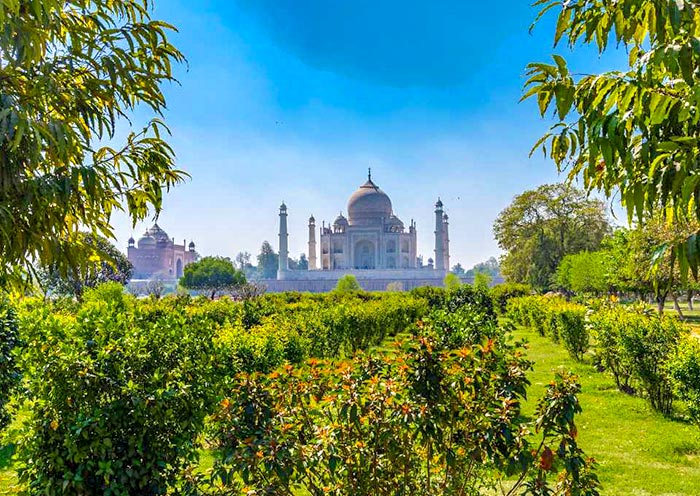
Today will be the big day for the Taj Mahal (World Heritage)! Your knowledgeable guide will pick you up from your hotel in the pre-dawn hours, so you can enjoy a serene sunrise viewing of the Taj Mahal bathed in an ethereal glow, away from the day's heat and crowds.
As you approach the magnificent Taj Mahal, you can admire its immaculate white marble facade glistens in the morning light. This remarkable architectural masterpiece, recognized as one of the New Seven Wonders of the World, serves as an eternal symbol of love. Emperor Shah Jahan built the Taj Mahal in the 17th century as a tribute to his beloved wife, Mumtaz Mahal.
Walking up to the Main Gate of the Taj Mahal is an experience in itself. The gate is carved from red sandstone and adorned with intricate floral patterns. It serves as a grand prelude to the awe-inspiring monument that awaits you. Stepping through, you enter the Charbagh, a formal Mughal garden divided into four perfect quarters by reflecting pools. This symmetry and balance foreshadow the architectural mastery evident in the Tomb itself.
The centerpiece of the Taj Mahal complex is the white marble mausoleum, which houses the cenotaphs of Shah Jahan and Mumtaz Mahal. The story goes that Shah Jahan deliberately built the minarets of the Taj Mahal - towers that serve as vantage points and landmarks - away from and tilted outwards from the main structure. In the unlikely event of a collapse, they would fall away from the Taj Mahal. So the tomb of his beloved wife would remain unharmed. Intricate floral designs, calligraphy, and semi-precious stone inlays that adorn the tomb's surface offer a glimpse into the unparalleled craftsmanship of the era, leaving you breathless with its beauty.
After marveling at the architectural mastery of the Taj Mahal, you will return to your hotel for a refreshing breakfast.
Then, you will continue the journey to Agra Fort (World Heritage). By the way, Shah Jahan was imprisoned in the Agra Fort by his son Aurangzeb. From his vantage point, he is said to have gazed upon the Taj Mahal, which served as a constant reminder of his beloved wife.
Agra Fort is a formidable red sandstone fort built by Emperor Akbar in the 16th century, serving as the seat of Mughal power for nearly a century. Your guide will lead you through the imposing gateways, showcasing the fort's rich history and architectural brilliance. Explore the various palaces, courtyards, and audience halls that once housed emperors, their families, and the Mughal court. Witness the exquisite craftsmanship evident in the intricate carvings, marble inlay work, and jali screens (decorative perforated stonework).
Next, you’ll explore Itmad-ud-Daula's Tomb, also known as the "Baby Taj" which was built by Empress Nur Jahan. This 17th-century mausoleum foreshadows the grandeur of the Taj Mahal with its intricate stone inlay work (perfected later), white marble, and geometric patterns, showcasing the evolving Mughal architectural style. Some might even say that its intricate architectural elements outshine the Taj Mahal!
After the tour, drive back to your hotel in Agra.
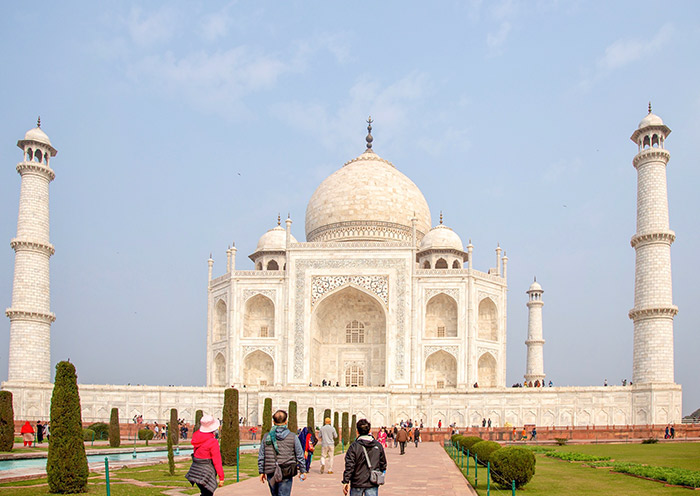
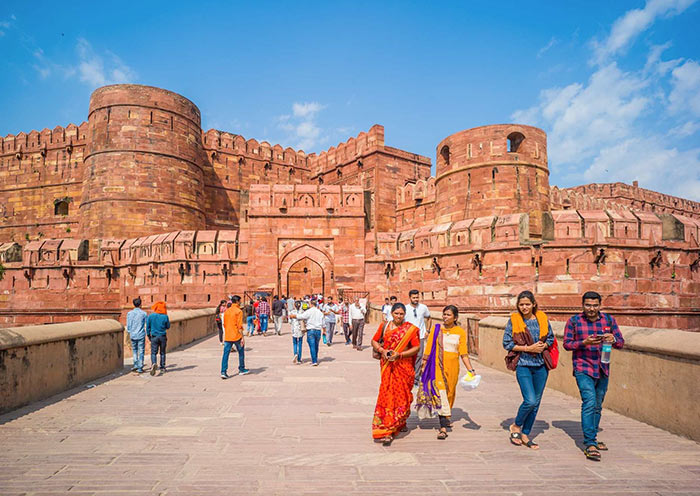
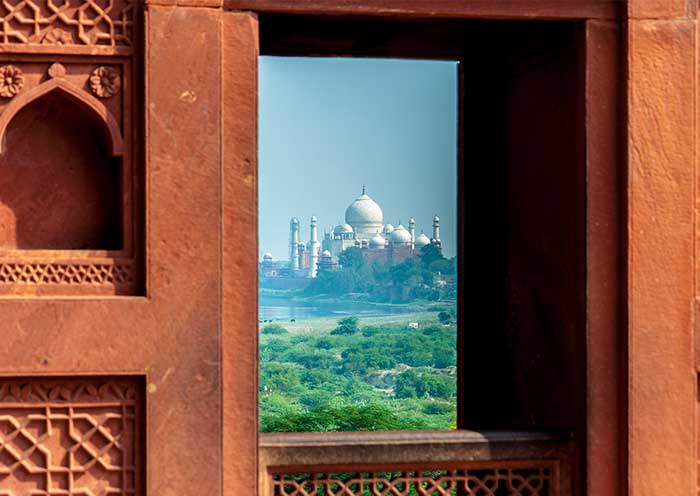
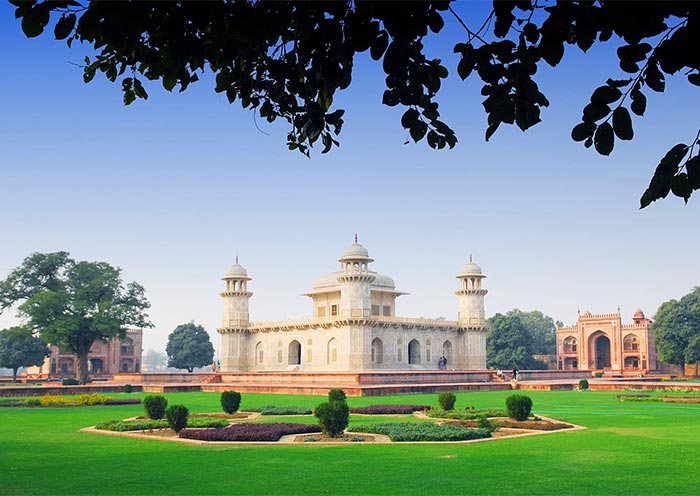
Begin your day early with breakfast at your hotel in Agra. Afterward, you will depart from Agra and make your way to Jaipur via Fatehpur Sikri (World Heritage). The journey covers approximately 250km and takes about 5 hours.
En route to Jaipur, make a stop at Fatehpur Sikri, meaning "The City of Victory”, which is 40 kilometers west of Agra. It served as the capital of the Mughal Empire under Emperor Akbar from 1571 to 1585. Visiting Fatehpur Sikri offers a deep dive into India's rich history, providing insight into the life and times of one of its most celebrated emperors, Akbar the Great. It is a prime example of Akbar's architectural genius, dominated by red sandstone buildings, showcasing a unique blend of Hindu, Jain, and Islamic architectural styles, a reflection of the syncretic culture developed under Akbar’s rule.
The city is divided into two main areas: the royal palace complex and the religious complex. The royal complex includes stunning buildings such as the Diwan-i-Aam (Hall of Public Audience), Diwan-i-Khas (Hall of Private Audience), Jodha Bai's Palace, Birbal's House, and Panch Mahal, among others. The religious compound features the Jama Masjid (Grand Mosque) and the tomb of Salim Chisti, a revered Sufi saint, which draws pilgrims from all over due to its sanctity and the belief in the fulfillment of wishes tied to it. One of Fatehpur Sikri’s most iconic structures is the Buland Darwaza (The Gate of Victory), standing at a height of 55 meters. It was erected by Akbar to commemorate his victory over Gujarat and is a magnificent example of Mughal architecture. The gate serves as the main entrance to the Jama Masjid.
Following the tour, drive on to Jaipur, which is approximately 210 kilometers away, taking around 4 hours from Fatehpur Sikri. Welcome to Jaipur, the vibrant capital of Rajasthan, India, known as the "Pink City" for its trademark building color. Jaipur's most striking feature is the rose-colored hue of its buildings in the old city center. his distinctive color scheme is attributed to a welcoming gesture by Maharaja Ram Singh who had the city painted pink in 1876 to honor a visit by the Prince of Wales (later King Edward VII). Upon reaching Jaipur, check in at your hotel and take some time to unwind.
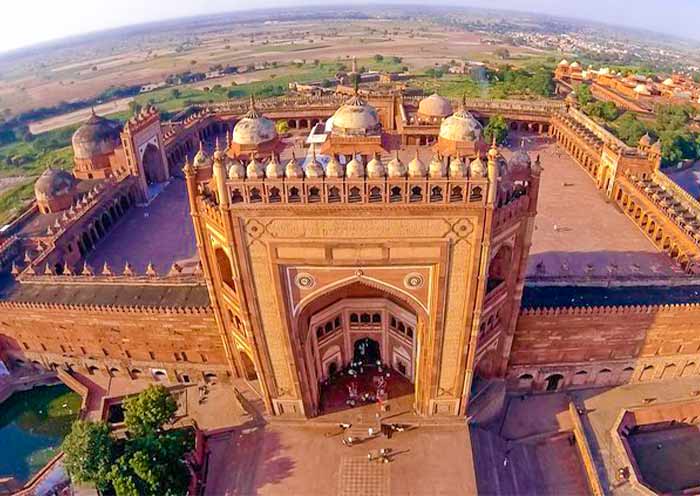
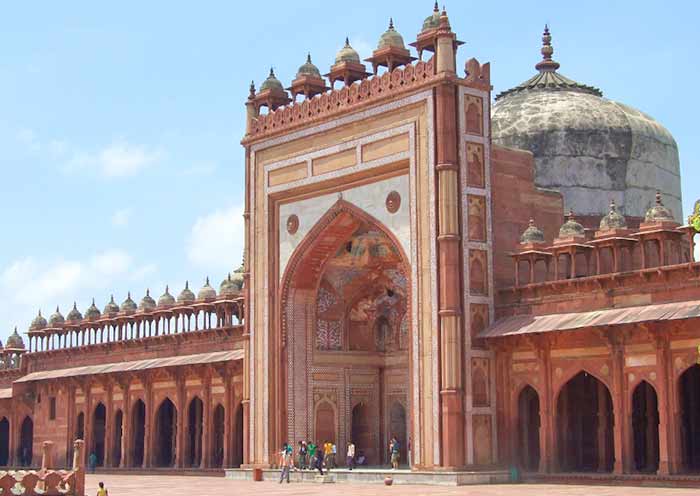
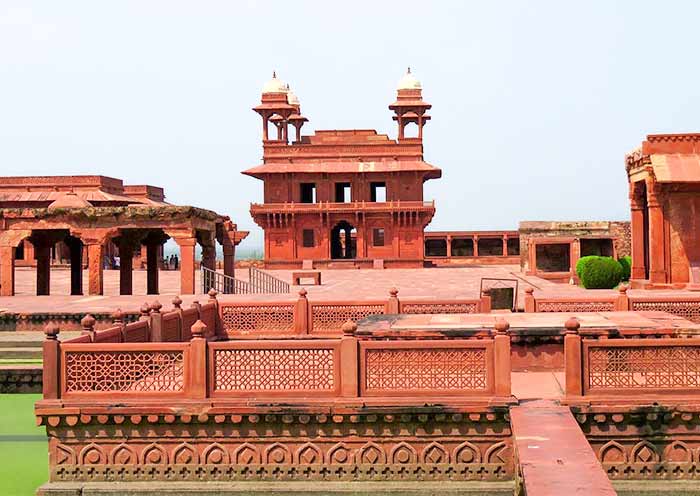
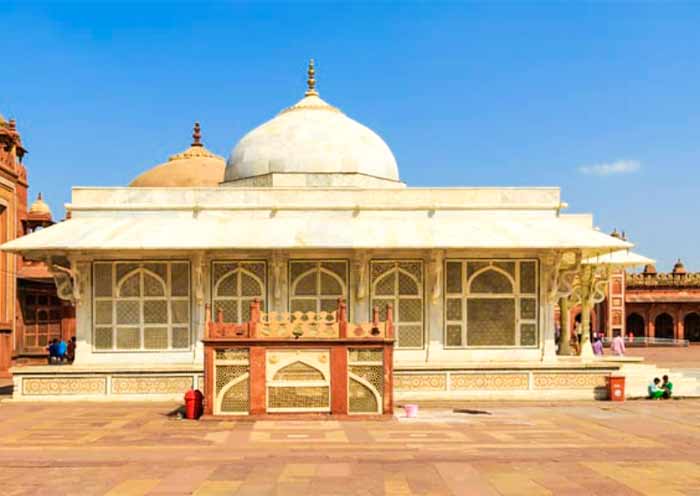
After a delightful breakfast, embark on a full-day Jaipur sightseeing led by your guide, including visits to the magnificent Amber Fort, the City Palace, the Hawa Mahal, and the Jaipur Jantar Mantar.
Your first destination is Amber Fort (World Heritage). The magnificent, formidable, honey-hued fort of Amber is an exquisite example of Rajput architecture. It is located in the rugged hills about 11km northeast of Jaipur, overlooking Maota Lake, and is a must-see sight in the city. Amber was the former capital of Jaipur state. This magnificent fort comprises an extensive palace complex, showcasing a fine blend of Rajput and Mughal architectural styles. It is built from pale yellow and pink sandstone, along with white marble, and features a grand palace, temples, and several ornate gates. Of particular interest is the Sheesh Mahal (Mirror Palace), where the walls are inlaid with exquisite mirrored motifs that dance in the flickering flame of even a single candle.
Tips: You can choose to take a jeep ride (optional) up to the Amber fork rather than take an elephant ride (optional).
You can reach the Amber fort through the Suraj Pol (Sun Gate) which leads to the Jaleb Chowk, the first main courtyard. Diagonally opposite is the Chand Pol (Moon Gate). From Jaleb Chowk, a flight of stairs leads up to the small Siladevi Temple, whose doors feature relief work in silver. The main palace is up next, which includes the Diwan-e-Am (hall for a private audience with the king) with carved columns and latticed galleries, the king’s apartments, the gate Ganesh Pol with beautiful arches, and Jai Mandir or Sheesh Mahal. Stand at one of the many arched windows of the palace and take in the rolling shrubland stretching up to the horizon and the scenic Maota Lake at the foot of the fort.
Next, head to the City Palace, situated in the old city of Jaipur. It is a sprawling complex that blends Rajput and Mughal architecture styles and serves as the royal residence of the Jaipur royal family. The palace houses several buildings, including Chandra Mahal, the Armoury, Diwan-i-Khas, and Diwan-i-Am Art Gallery, along with courtyards and gardens. Among them, Pitam Niwas Chowk (Courtyard of Love) is a photographer's delight. It is famous for its 4 colored gates, each representing a different season. The Peacock Gate depicts autumn, the Lotus Gate signifies summer, the Green Gate represents spring, and finally, the Rose Gate embodies winter.
No tour would be complete without visiting Hawa Mahal (Palace of Winds). It is renowned for its unique 5-story exterior, resembling the honeycomb of a beehive. This architectural wonder is built of red and pink sandstone, and features an incredible 953 intricately carved windows. These windows, resembling a honeycomb design, gave the building its name ("hawa" meaning "wind" in Hindi) and allowed royal ladies to observe everyday life and festivals in the street below without being seen. The clever design also facilitate the circulation of cool breezes throughout the palace, providing natural air conditioning, especially during the hot summer months. Hawa Mahal is an architectural marvel that blends Hindu Rajput architecture with Islamic Mughal architecture. The facade of Hawa Mahal is a stunning sight, particularly when bathed in the golden light of the early morning or late afternoon.
Immediately behind the Hawa Mahal is the Jaipur Jantar Mantar (World Heritage), considered one of the oldest astronomical observatories in the world, built by Maharaja Sawai Jai Singh II. The observatory houses the world's largest stone sundial and features 16 devices designated to measure time, observe planetary motion around the sun, and keep track of celestial bodies. The geometric devices of the observatory are both functional and architecturally fascinating, offering a glimpse into the advanced astronomy studies of the 18th century.
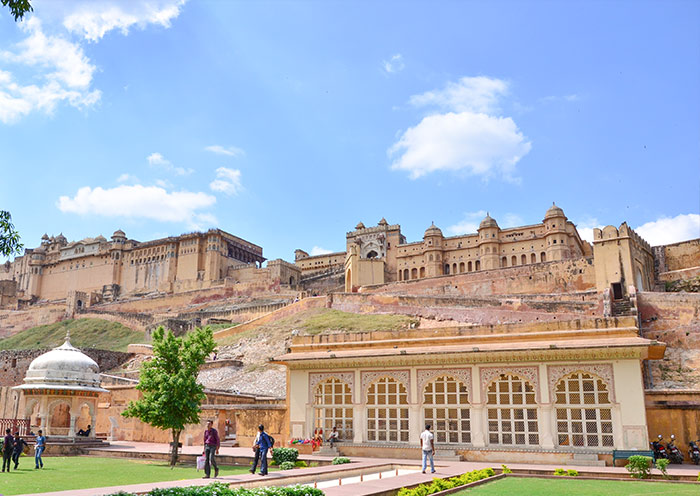
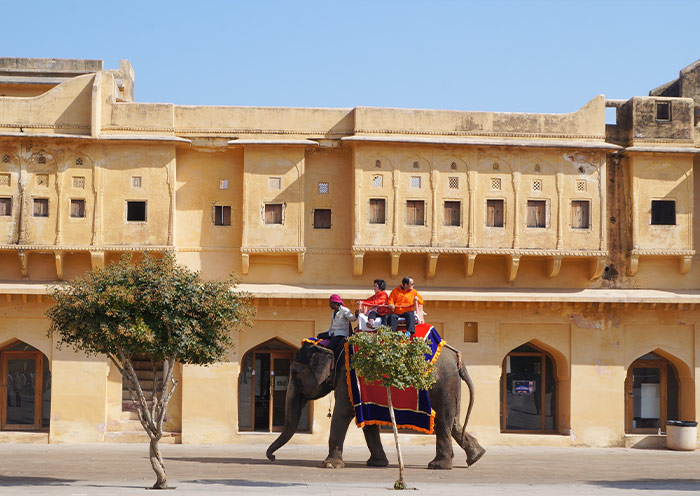
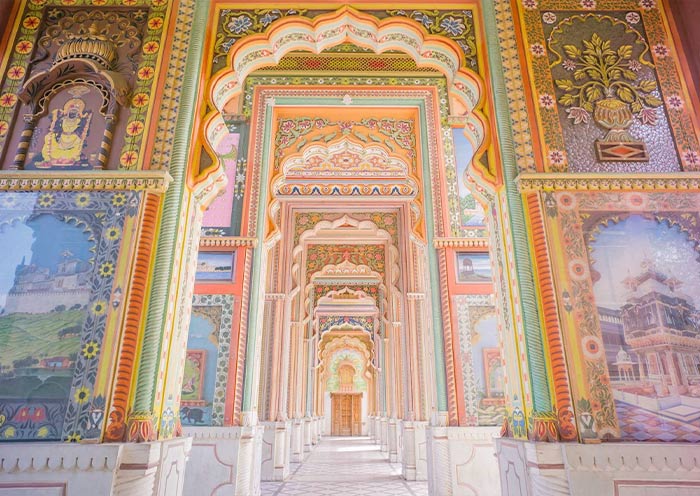
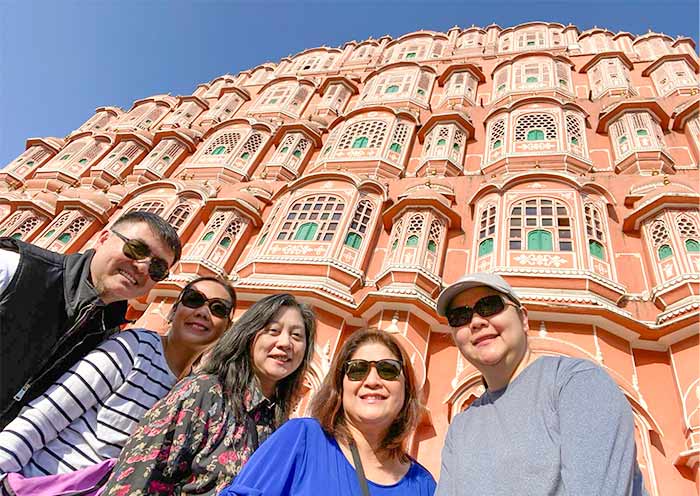
Today will be a relaxing day as you head back to Delhi from Jaipur, marking the end of your visit to the beautiful Pink City. The distance between Jaipur and Delhi is approximately 308 kilometers, and the journey takes around 5.5 hours.
You can enjoy the morning in Jaipur Local Bazaar before embarking on the journey back to Delhi. You would love to take a Jaipur Local Bazaar walking tour with your tour guide. Jaipur is a fantastic shopping destination, with lots of bazaars showcasing wonderful Rajasthan artifacts such as textiles, gemstones, silver, and pottery. One local specialty is blue pottery, which features hand-painted vessels adorned with floral motifs and geometric patterns in combinations of blue, white, and occasionally other colors.
After your time at the Jaipur Local Bazaar, proceed to Delhi and relax at your lovely hotel. Take the opportunity to unwind, pack your belongings, and ensure you are well-rested for your early morning flight to Paro (Bhutan) the following day.
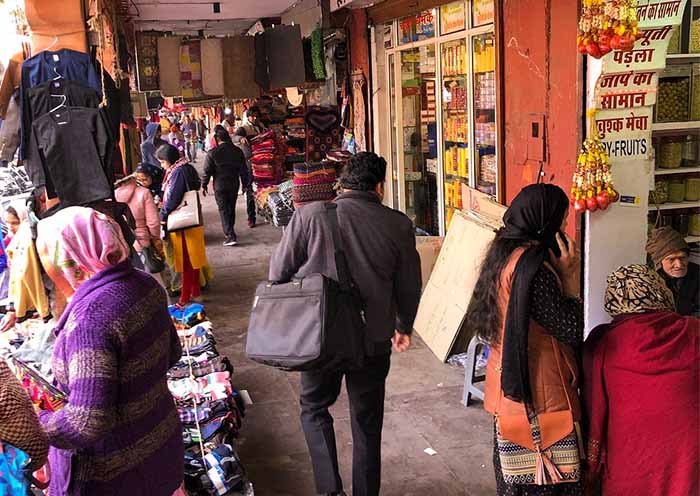
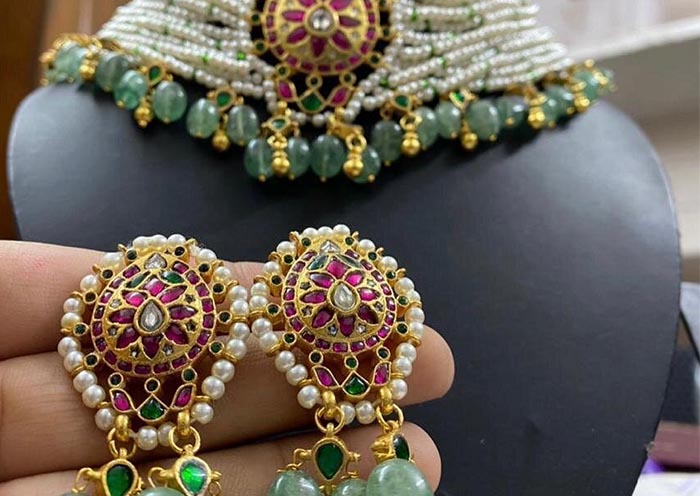
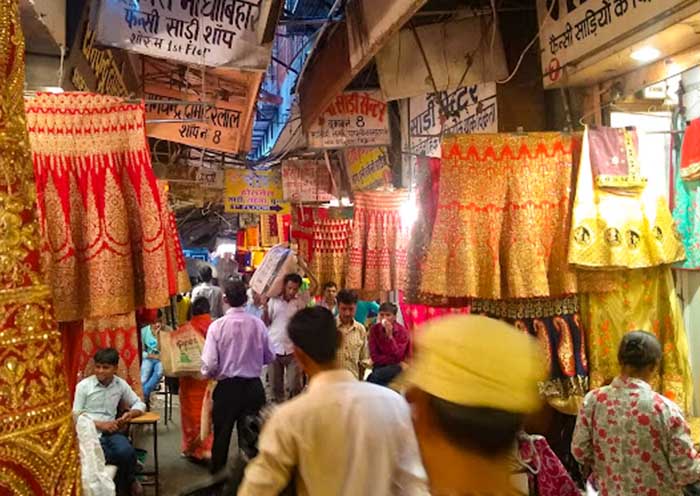
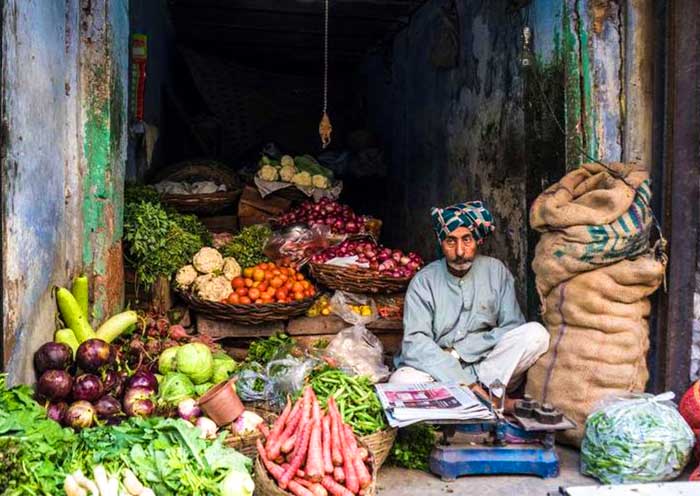
Tashi Delek! Welcome to Bhutan, the Last Shangri La in Pristine Himalayan Kingdom. Take a deep breath and enjoy the refreshing breeze in the happy country where 71% of the land is covered with forests. Your guide and driver in Paro will greet you at Paro International Airport, Bhutan's only international airport.
Paro (2,270m) is the first city for most guests to reach Bhutan. It is known for Tiger's Nest which makes Paro a must-visit destination in Bhutan. For nature and culture lovers, Paro is a picturesque place that combines spirituality, natural beauty, and cultural heritage. You may have the chance to attend the colorful annual Paro Tshechu Festival if you visit Paro in early to mid-March. The festival falls on the 10th day of the second lunar month of the Bhutanese calendar. In some years, the festival might start slightly earlier, around March 10th or 15th. The festival celebrates the birthday of Guru Rinpoche, a revered figure in Bhutanese Buddhism.
You will not miss a stop at the Paro Airport Birds Eye View Point on the way to you hotel, which is a great spot to enjoy a panorama view of Paro Airport, Rinpung Dzong (Paro Dzong), National Museum (Ta Dzong), Paro Chu River, and the stunning Paro Valley itself. Don't forget to ask your guide for more fascinating information about this remarkable airport.
Base on arriving at Paro Airport before noon, this afternoon you will head to Thimphu (50km,1.5 hours). Once in Thimphu (2,340m), you can enjoy your exploration in Bhutan’s capital, including visiting the Buddha Dordenma Statue (Bhutan Point), the National Memorial Chorten, and Tashichho Dzong.
You will visit the iconic landmark of Thimphu city - the Buddha Point first. It is the largest sitting Shakyamuni statue in the world that completed in 2015. The statue embodies an ancient prophecy of radiating happiness and peace throughout the world. In addition to admiring its impressive height of 51.5 meters, constructed of bronze and gilded in gold, you will also be able to see 125,000 smaller Buddha statues placed within it. Moreover, from this vantage point, you can enjoy a magnificent view of the Thimphu Valley.
As the largest city in Bhutan, Thimphu lacks traffic lights and a railway system. When you enter the city, you can visit the National Memorial Chorten and experience it as the locals do. It is customary to follow the footsteps of the Bhutanese people and perform a clockwise kora (circumambulation) around the Chorten while offering prayers. This will provide you with numerous opportunities to engage with the locals and learn about their daily lives, as well as their philosophy on happiness.
The National Memorial Chorten is the most visited landmark in Thimphu. Constructed in 1974 in memory of the Third King, His Majesty Jigme Dorji Wangchuk (known as the Father of Modern Bhutan), by his mother, it reflects the late king's vision of promoting world peace and prosperity. The Chorten follows a Tibetan-style architecture and is adorned with remarkable paintings and intricate sculptures. You can observe the traditional stupa design, featuring a pyramidal pillar topped with a crescent moon and sun.
If time permits and you have an interest in Bhutan's national animal, you can visit the Motithang Takin Preserve. There, you can observe the unique creature that is said to have been created by the legendary Drukpa Kunley (Divine Madman). According to legend, Drukpa Kunley combined the head of a goat with the body of a cow to create the takin. Also if time permits you can pay a visit to Zilukha Nunnery (Drubthob Goemba Monastery) which is the biggest nunnery in Bhutan. A visit to the nunnery can give you a nice view of the Tashichho Dzong.
Then, you should not miss the visit to Tashichho Dzong (Thimphu Dzong), which has served as the seat of the government since 1952. This magnificent fortress-like structure is located on the western bank of the Wang Chu River. It seamlessly integrates with the entire valley and stands as the ultimate center of power in Bhutan. It houses the offices of the current reigning monarch, the Fifth King (Jigme Khesar Namgyel Wangchuck), as well as the ministries of internal affairs and finance. Additionally, it serves as the residence of the spiritual leader of Bhutan, the Je Khenpo, and hosts the central religious institutions of the country. During the summer season, the Je Khenpo resides in the Thimphu Dzong, while in the winter season, they relocate to Punakha Dzong. Walking around the Dzong, you will discover that it is an impressively large structure surrounded by well-kept lawns and beautiful gardens. Tashichho Dzong has two main entrances. One entrance leads to the administrative section in the south, while the other, situated in the north, grants access to the monastic quarter where the Thimphu Tshechu Festival and masked dances are performed.
Note: The opening hours of Thimphu Dzong are from 9 AM to 5 PM on weekdays and from 10 AM to 4 PM on weekends. It is required to have a tour guide accompany you for a visit to the Dzongs. Before entering for a visit, security checks are conducted.
If time permits and you can visit the Folk Heritage Museum for a traditional Bhutanese dinner (Optional) and try archery (Bhutan National Sport) there. The museum was established in 2001 through the initiative of Her Majesty Ashi Dorji Wangmo Wangchuck, the Queen Mother of Bhutan (Mother of the 5th King). It is housed in a three-storied, 19th-century traditional house, offering visitors a glimpse into the traditional Bhutanese lifestyle. The museum showcases artifacts from rural households, including a collection of typical household objects, tools, and equipment. Additionally, if you arrive between Thursday and Sunday, make sure to visit the Thimphu Weekend Market. You will also enjoy a leisurely evening stroll to the Craft Bazaar, where over 80 stalls showcase the traditional handicrafts and creations of local artisans, offering you a delightful shopping experience.
Afterward, you can check in at your cozy hotel in Thimphu, where you can rest and acclimate yourself to any time difference.
Arrival Ideas:
Paro International Airport, with the airport code PBH, is Bhutan's sole international airport. Approximately 30,000 people arrive at Paro Airport each year. The easiest and most convenient way to travel from Delhi to Bhutan is by air. Bhutan Airlines and Drukair are the only two Bhutanese airlines offering daily direct flights between Delhi and Paro. The flight duration is approximately 2 hours and 20 minutes, covering a distance of 1221 kilometers. Some indirect flights from Delhi to Paro (via Nepal) take around 3 hours and 30 minutes, including waiting time at Kathmandu's Tribhuvan International Airport. The flight schedule from Indira Gandhi International Airport (DEL), the largest airport in India based in Delhi, to Paro International Airport (PBH) may vary depending on the month.
Kind Reminds:
1.You can contact us to book your flight to Paro and land directly in Bhutan.
2.Visitors of all nationalities, except those from India (require a permit), require an E-visa (40USD/pax) before entering Bhutan. All nationalities are welcome to visit Bhutan, and there are no specific restrictions on granting visas to enter the country.
3.Visitors from Indiaare able to apply for a permit but are required to hold an Indian passport or an Indian voter ID card.
4.Visitors from Bangladesh and the Maldives also require a visa, which can be applied for and approved in advance of travel or upon arrival in Bhutan.
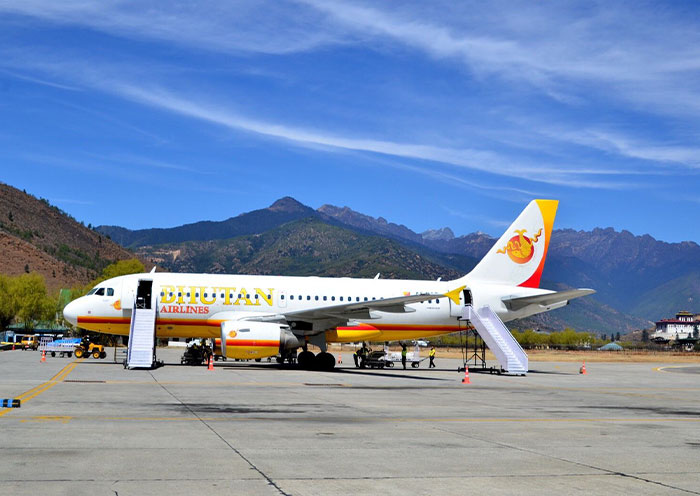
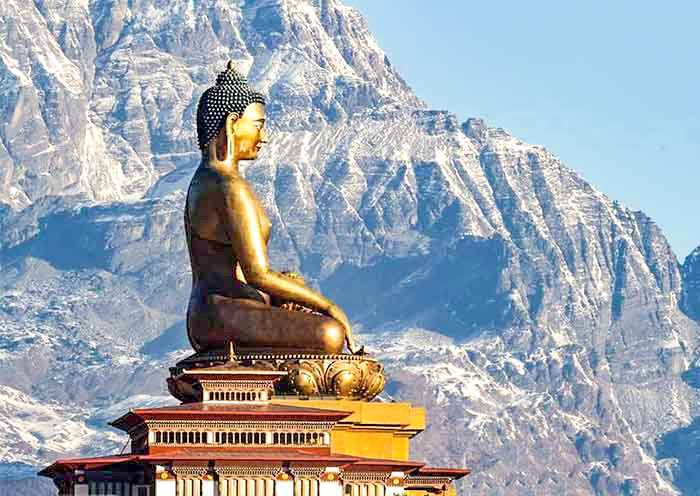
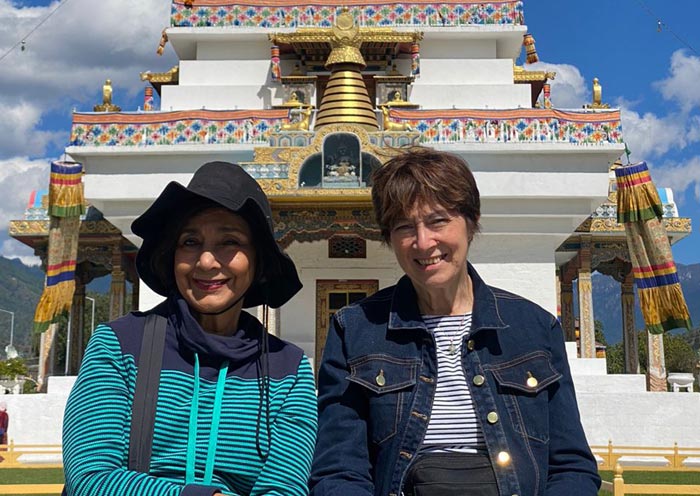
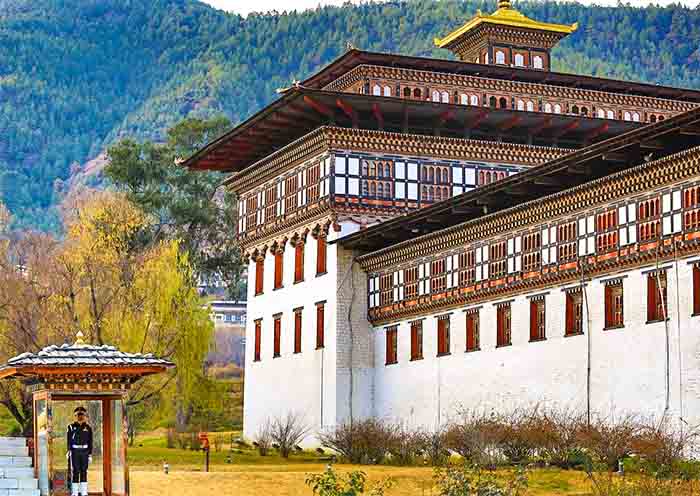
Today, you will travel from Thimphu to Punakha via Dochula Pass (74km, about2.5 hours). This trip is more than just a drive; it is a voyage through changing altitudes and diverse landscapes, offering a visual spectacle. Starting from the higher altitude and cooler climate of Thimphu (2,300m), the drive takes you along the national highway, ascending through the majestic Dochula Pass (3,120m). Upon crossing the pass, you'll descend into the warm and verdant Punakha Valley (1,330m).
En route, you will stop at Dochula Pass (Dochu La Pass), renowned as one of the most beautiful mountain passes in Bhutan. If weather permits, you will be treated to a breathtaking panoramic view of the Himalayas, including Bhutan’s highest mountain peak, Mt. Gangkar Puensum (7,570m). You will have the delightful option to savor the view while enjoying a cup of coffee in the picturesque cafeteria. At the Dochu La Pass summit, you will encounter the 108 memorial chortens (Buddhist shrines) and clusters of prayer flags fluttering in the wind, creating an ambiance of tranquility and spirituality. These chortens (stupas), known as Druk Wangyal Khang Zhang Chortens, were constructed as a memorial to honor the Bhutanese soldiers who lost their lives in the battle against Assamese insurgents from India, and also as an offering for global peace.
Then, your journey continues towards Punakha. Along the way, you will take a hike to Chimi Lhakhang (Chime Lhakhang), which is highly recommended as a culture shock tour. As you stroll through rice paddies and a charming settlement adorned with painted houses and numerous craft shops, you will eventually reach Chimi Lhakhang (Fertility Temple). Constructed by the cousin of Drukpa Kunley, the temple was built to commemorate the victory of Drukpa Kunley (Mad Saint & Divine Madman) over the demon of Dochu La using his "magic thunderbolt of wisdom "(phallus). That is why you can see the symbol of the phallus scattered throughout. Lama Drukpa Kunley was adored by the local people due to his unconventional teaching methods of Buddhism, which involved singing, humor, and an exaggerated manner often intertwined with sexual overtones. Chime Lhakhang is renowned as a sanctuary of fertility, and many childless women sought blessings from the lamas at the monastery. It is believed that these couples often find success in conceiving soon after their visit. If you are lucky, you may encounter the monks there blessing pilgrims or women who wish to conceive by tapping their heads with a 25cm wooden phallus. In Bhutan, it is common for local people to utilize the phallus symbol to ward off the evil eye and deter malicious gossip.
After that, drive to Punakha city, the old capital of Bhutan before 1955. It is located at the confluence of the Mo Chhu (Mother River) and Pho Chhu (Father River). Dominating the river junction is the magnificent Punakha Dzong, the winter residence of Je Khenpo (head abbot of Bhutan) and about 1,000 monks. Occasionally, you'll spot monks draped in red robes passing by, their rhythmic chanting and prayers echoing in the air. Punakha Dzong, the second oldest and second largest Dzong in Bhutan serving administrative and monastic functions holds a legendary tale. It is said that Guru Rinpoche (Padmasambhava) prophesied the arrival of a person named Namgyal built a Dzong on a hill resembling an elephant. In 1637, Shabdrung Ngawang Namgyel, the unifier of Bhutan, received a divine vision guiding him to construct a Dzong at this site. All of Bhutan’s kings have been crowned here and In 2011, the Dzong bore witness to the royal wedding ceremony of His Majesty Jigme Namgyel Wangchuck, the 5th King of Bhutan, as he married Queen Jetsun Pema. As the most beautiful Dzong in Bhutan, if you visit in April, you won’t miss the stunning violet blossoms of the jacaranda tree outside Punakha Dzong. The jacaranda typically blooms from late March to early May, During this time, the grounds of Punakha Dzong transform into a magical carpet of purple under the clear blue skies, creating a truly breathtaking sight. If you visit during the Punakha Tshechu Festival, you can enjoy the mesmerizing masked dances and witness the exhibition of a large thangka depicting the Zhabdrung (Shabdrung, the father of Bhutan) once a year. You can have fun with locals who flood here dressed in Bhutan’s national attire, with men wearing Gho and women wearing Kira.
After crossing the Bazam Bridge, you can walk inside the Punakha Dzong and take your time to admire this stunning example of Bhutanese Dzong architecture which was built of stone, pounded mud, and a considerable amount of timber (without nails, written plans or designs). There is a six stories central tower called utse standing in the yard of the Punakha Dzong. As the highest architecture within the Dzong, utse houses the most sacred temples and shrines and contains important religious artifacts, thangkas, statues, and texts. This Dzong has three docheys (courtyards) instead of the usual two. The first (northern) courtyard is for administrative functions and houses a huge white Victory Chorten and Bodhi tree. The second courtyard houses the monastic quarters and is separated from the first by the utse. In this courtyard, there are two halls; one of Ugyen Wangchuck (the King of Bhutan) and another hall where the King was decorated in 1905 with the Order of the Knight Commander of the Indian Empire by John Claude White. In the third (southernmost) courtyard is the temple where the remains of the Pema Lingpa (a treasure revealer, Five Terton Kings) and Shabdrung (founder of Tshechu Festival and Bhutan National Dress) are preserved. At the south end, there is the kunrey, or "hundred-pillar" assembly hall with exceptional murals that depict the life of Buddha.
Optional Bhutan Punakha Experience:
Punakha Rafting: You have option to go rafting in the Po Chu and Mo Chu rivers, offering unique views of the Punakha Dzong that not possible from land.
Overnight in Punakha and get ready for your next day's trip.
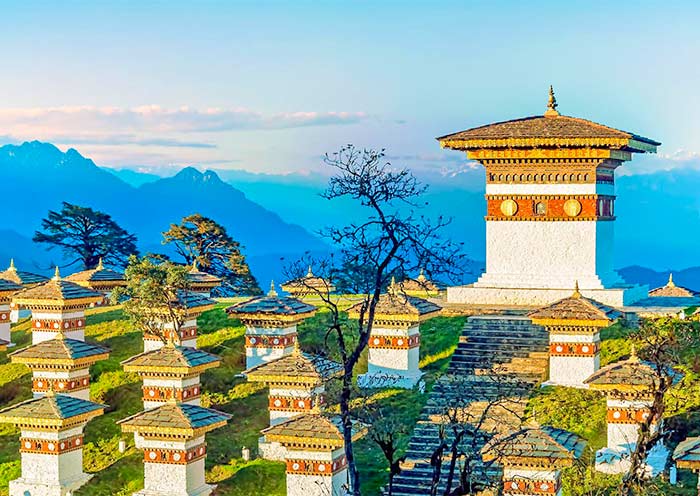
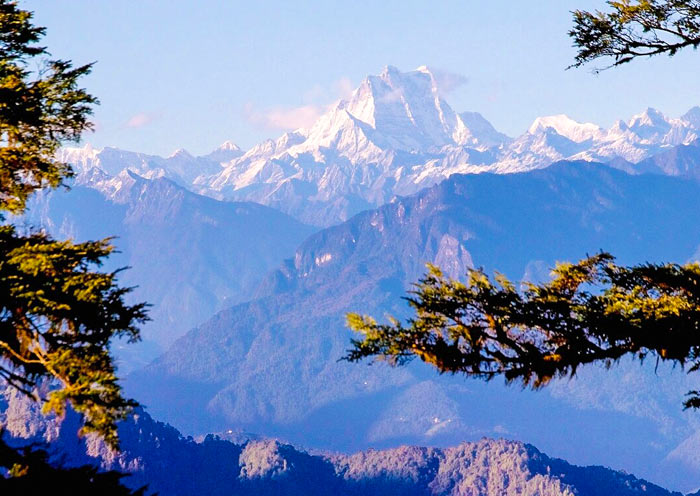
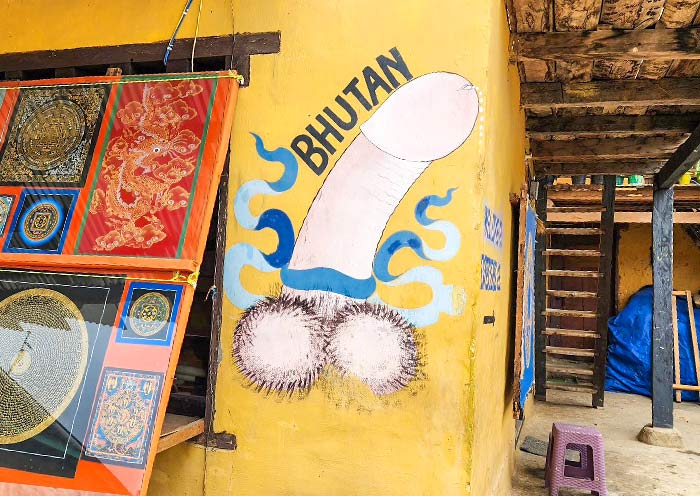
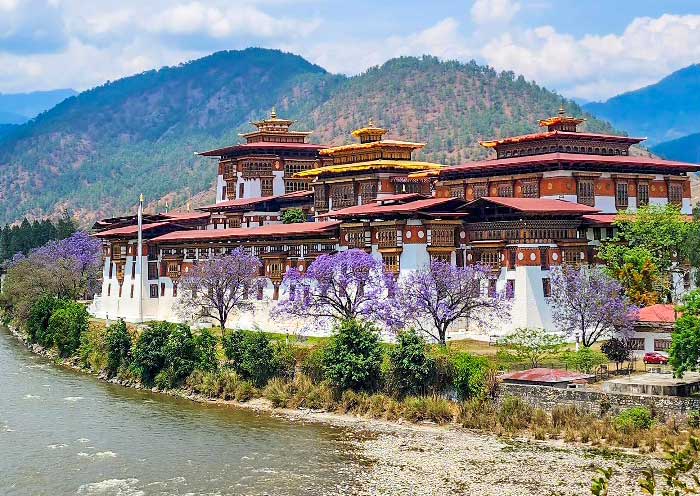
Today, as you cross Punakha Suspension Bridge, one of Bhutan’s longest pedestrian suspension bridges (160m), you will be rewarded with breathtaking views of the lush Punakha Valley and the glacier-fed Po Chu River below. After that, you will walk alongside terraced rice paddies and follow a trail to Khamsum Yulley Namgyal Chorten (Hike 1 hour or less). Along the way, you may encounter farmers working in the fields, either manually or with the help of an ox and plow.
The Khamsum Yulley Namgyal Chorten (Stupa) was built in 1990 by the Queen Mother, Ashi Tsering Yangdon Wangchuck, who is the mother of the 5th King Jigme Khesar Namgyel Wangchuck. The purpose of its construction was to ward off evil forces and bring peace to Bhutan and the world. Unlike typical stupas, the Khamsum Yulley Namgyal Chorten is dedicated to the protective deities in Bhutanese culture. Each floor of the chorten pays tribute to different protective deities. This chorten exemplifies a harmonious blend of Bhutanese art, architecture, and traditions. It took Bhutanese carpenters, painters, and sculptors 9 years to complete this distinctive Bhutan-style pagoda. Inside Khamsum Yulley, you can admire the sculptures, and as you continue climbing the steep stairs, you will reach the top level. From there, you can venture onto the roof of Khamsum Yulley Namgyal Chorten and enjoy expansive views of the Punakha. The landscape undergoes a dramatic transformation with the changing seasons, with lush green rice paddies in the summer transforming into captivating golden fields in the autumn.
Then, make your way back to Paro (110km, about 3.5h) via Dochu La Pass. In Paro, you will have the opportunity to visit Tamchog Lhakhang, Paro Dzong, and the Bhutan National Museum.
On the way back to Paro, you won’t miss the famous Tamchog Lhakhang (Tachog Lhakhang), situated by the Paro river. There, you will have the opportunity to walk across a unique iron chain bridge adorned with colorful fluttering prayer flags. Both the Lhakhang and the iron bridge were constructed by the revered saint Thangthong Gyalpo (1385 - 1464), who was renowned as the Iron Bridge Maker. Take delight in exploring his historic architectural creations that have stood the test of time.
After reach Paro, you can pay a visit to Paro Dzong and Bhutan National Museum. Paro Dzong (Rinpung Dzong) is a magnificent fortress stands tall and proud, serving as a beacon of history and culture in Bhutan. Rinpung Dzong was constructed in 1646 by Shabdrung Ngawang Namgyal (1594-1651), a pivotal figure in Bhutanese history who is revered as the founder of the modern Bhutanese state and a national hero. His enduring legacy continues to shape the country's identity and cultural landscape. Located near the pristine Paro Chu River, Paro Dzong can be accessed via a traditional wooden cantilever bridge, providing you breathtaking panoramic views of the enchanting Paro Valley. If you hike a little further, you will reach the Bhutan National Museum (Ta Dzong), which holds the distinction of being Bhutan's tallest building. Originally constructed in 1649 as a watchtower overlooking the Paro Dzong, it was later transformed into the National Museum of Bhutan in 1968. At the museum, you can immerse yourself in a rich collection of ancient artifacts such as pottery, armor, thangkas, masks, stamps, photographs, statues, costumes, relics, stone axes, and religious paintings.
After that, overnight in Paro.
Today, you will receive special offers from the AOT team: Receive Bhutan National Dress Experience for free.
Free Time Ideas:
1. Visit Paro Local Market:Why not dress in Bhutan's National attire to visit the Paro Local Market? Check what Bhutanese eat for their daily life? What is include in Bhutan Dishes? Colorful Chili peppers, dry cheese, potatoes, apples...
2.Try BhutanNational Game (self-pay for the fee): Archery is the favorite pastime for Bhutanese. It has a history of over 2,000 years and was declared Bhutan's National Sport in 1971. Targets at traditional Bhutanese tournaments are placed at both ends of a 140m range (Olympic distance is 70m). Enjoy your time by holding a bow and arrow.
3. Bhutanese Wood Turning (Shagzo): Visit a small factory specializing in produce bowls (dapa), cups (dza phob), plates, and containers ranging a wide gamut of shapes, sizes, and colors. These products are crafted from special wood burls and tree roots found in Bhutan. Traditionally, wooden bowls and cups are used to serve food in Bhutanese households.
Feel free to contact your guide in advance for more travel advice and tips tailored to your interests.
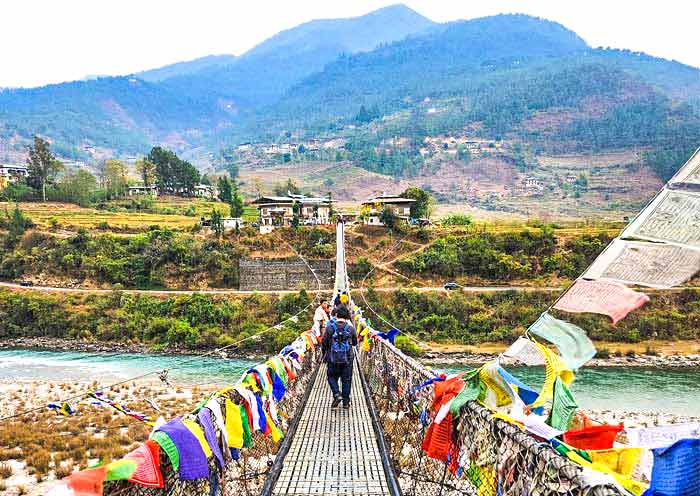
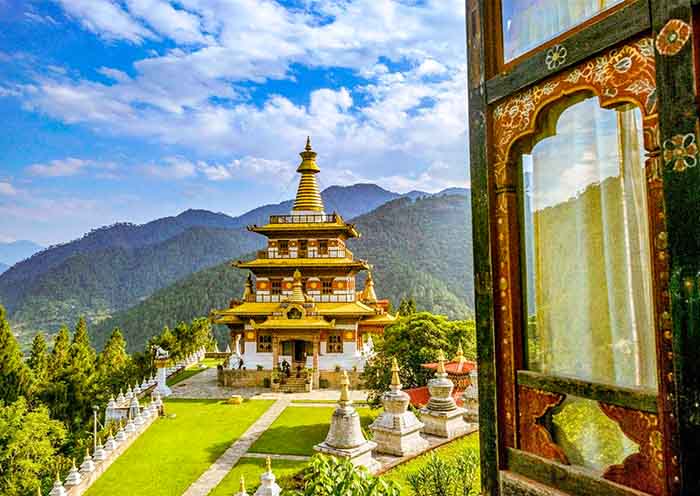
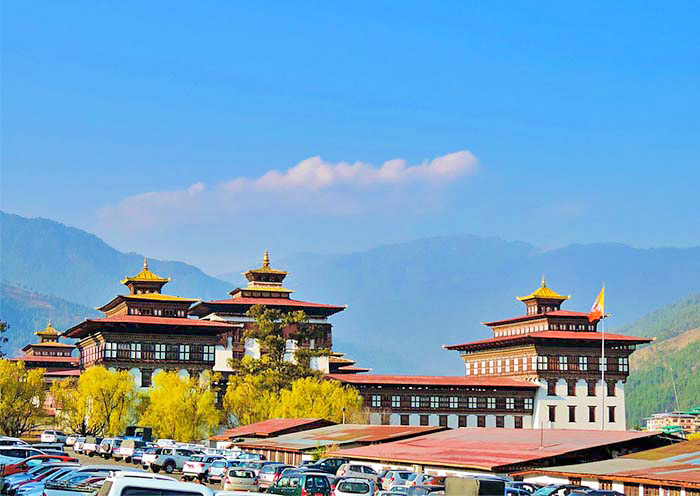
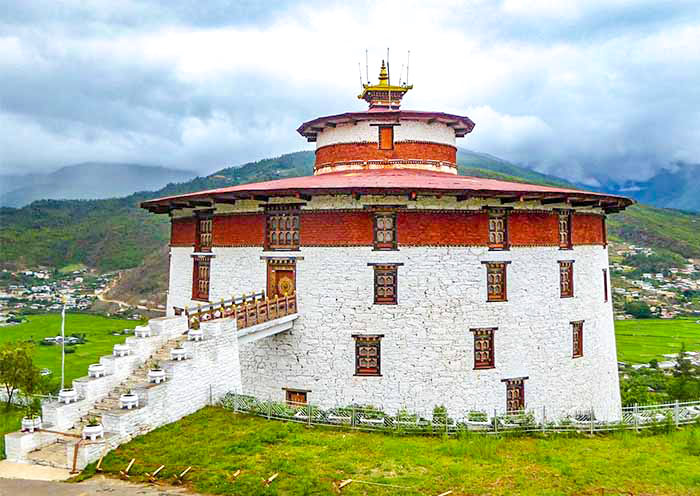
This morning, you will enjoy the exciting hiking tour to Tiger's Nest, the landmark of Bhutan and the most famous holy monastery in the country. It is about a 12km drive (over 0.5 hour) from Paro city to the start point of the Tiger's Nest hike route.
Usually, it may takes about 2.5 hours to reach Tiger's Nest Monastery (Paro Taktsang) on foot. The entire Tiger's Nest Hike takes around 5 to 6 hours, with about 2.6km of uphill trekking and about 2.6km of downhill walking. You have the option to rent a horse at the designated place if you prefer. Riding a horse (self-payment required), it takes about 1.5 hours to reach the halfway point on the mountainside. From there, you need to say goodbye to your horse and hike for another 1.5 hours to reach the Tiger's Nest Monastery. At the halfway point, there is a Taktsang Cafeteria where you can have a buffet lunch and enjoy coffee and tea. What is more it is the first viewpoint where you can look up at Tiger's Nest Monastery, the incredible religious site of Buddhists. As the viewing position ascends, the outline of Tiger's Nest Monastery becomes increasingly clear. On the journey ahead, you can enjoy the hike in Bhutan’s forest and will see more and more prayer flags and prayer wheels, left behind by the Bhutanese people who come here to worship. You will also have a panoramic view of the beautiful Paro Valley below. If you visit in April, you will have the opportunity to see the high-altitude rhododendrons blooming, creating a stunning display of red clouds amidst the mountains.
Then, you will stand right opposite the Taktsang Goemba (Tiger's Nest Monastery) and admire Bhutan's most iconic cultural landmark, which is renown as one of the world's top ten super monasteries. The Tiger's Nest (3,120m) is sited on the side of a cliff at a height of 900m above the Paro Valley (2,270m). According to legend, the Indian sage Guru Padmasambhava (Guru Rimpoche, the founder of the Nyingma school of Tibetan Buddhism and the builder of the first monastery in Tibet - Samye Monastery) arrived at the location of Tiger's Nest Monastery in the 8th century. It is said that he rode a tigress and subdued demons before spending 3 months meditating in the mountain caves here. This eventually led to the formation of the present-day Tiger's Nest Monastery. Throughout history, this place has been considered a sacred site by Buddhist luminaries. However, it wasn't until 1692 that the current structure of Tiger's Nest Monastery took shape. In 1998, a devastating fire caused significant damage, but it was reconstructed in 2005, closely resembling the original architectural design. If you are interested you can hike into the monastery to explore more (no photo inside). Today, Tiger's Nest Monastery, one of the most visited tourist attractions in Bhutan, is revered as the holiest pilgrimage site for Bhutanese people to visit at least once in a lifetime.
After completing the Tiger's Nest hike, you will proceed to Drukgyal Dzong, where you will have the opportunity to catch a glimpse of Mount Jomolhari (7,570m). Known as the "Mountain Goddess" and the tallest mountain in Bhutan, Mt Jomolhari is considered a sacred abode for deities and spirits, earning the title of "Sacred Mountain". Know as the Fortress of the Victorious Drukpa, Drukgyal Dzong was believed to have been built in 1646 by Zhabdrung Ngawang Namgyal who is the unifier and founder of the Bhutanese nation-state. The building was used as an administrative centre until 1951, when a fire caused by a butter lamp destroyed it. In April 2016, to celebrate the birth of the Dragon Prince, Gyalsey His Royal Highness Jigme Namgyel Wangchuck, as well as to commemorate the arrival of Zhabdrung Ngawang Namgyel to Bhutan in 1616 AD and the birth year of Guru Rinpoche, then Prime Minister Tshering Tobgay announced that the dzong will be restored and reinstated to its former glory upon the command of His Majesty King Jigme Khesar.
Then, it is time to visit Kyichu Lhakhang, also known as the Temple of the Thousand-armed and Thousand-eyed Avalokiteshvara. It is one of the 108 Buddhist temples built by King Songtsen Gampo in the 7th century (around 659 AD), and it is believed to have been constructed to subdue the left leg of the Tibetan witch. Kyichu Lhakhang is also one of the oldest Tibetan Buddhist temples in Bhutan and serves as a venue for important celebrations of the Bhutanese royal family. In the main hall of Kyichu Lhakhang, you can see the revered statue of an eight-year-old Shakyamuni Buddha, believed to have been created during the same period as the Jowo statue in the Jokhang Temple in Lhasa, Tibet. It is considered a national treasure of the Kingdom of Bhutan. Apart from housing many precious historical artifacts and Buddhist scriptures, the temple also enshrines the relic stupa of Dilgo Khyentse Rinpoche (1910-1991), a renowned master of the Nyingma tradition. Additionally, there is a piece of iron chain forged by Tangtong Gyalpo, who was the former head of the four major Tibetan Buddhist schools and is known as the Iron Bridge Living Buddha and the father of Tibetan opera.
If time permits and you are interested, you can also visit a local farmhouse, which provides a fascinating glimpse into the lifestyle of a farmer. Finally, head back to Paro for an overnight stay.
Optional Bhutan Paro Experiences:
1.Bhutan Traditional Hot Stone Bath (1 hour).
2.Lighting butter lamps for blessings at Kyichu Lhakhang (108 lamps).
3.Dinner with Bhutanese Culture Dance Show.
Kind Reminds:
1.The best time to visit Tiger's Nest is from March to May and from October to December. After noon, the monastery will be hidden in the shadow of the cliffs, so it's recommended to depart early if you want to capture good photos.
2.Tiger's Nest offers horse riding services to go uphill, but the horse ride is only available up to a designated point. From there, you still need to hike to reach the monastery. When descending, you must walk the entire way as horse riding services are not provided.
3. Mobile phones and backpacks are not allowed inside Tiger's Nest Monastery. Personal belongings can be stored at the entrance. If you wish to light butter lamps, make sure to have some cash ready before storing your belongings.
4. Along the way, you may encounter stray dogs. Please be mindful, give them space, and avoid disturbing them.
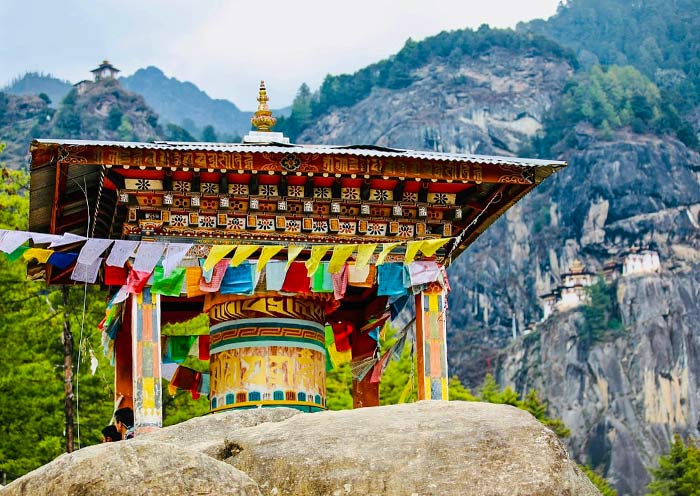
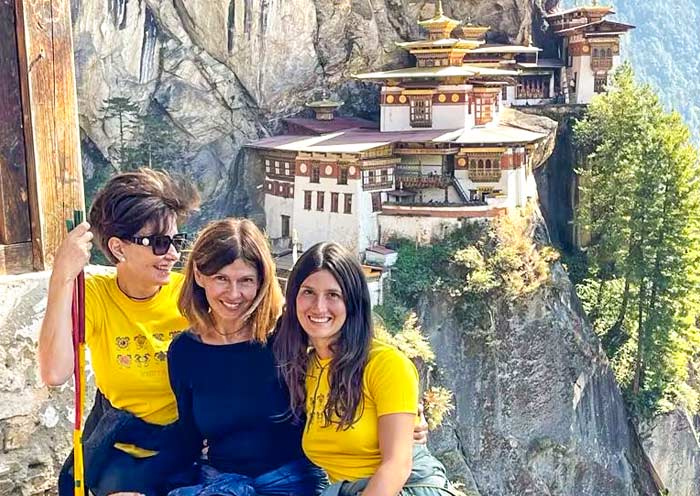
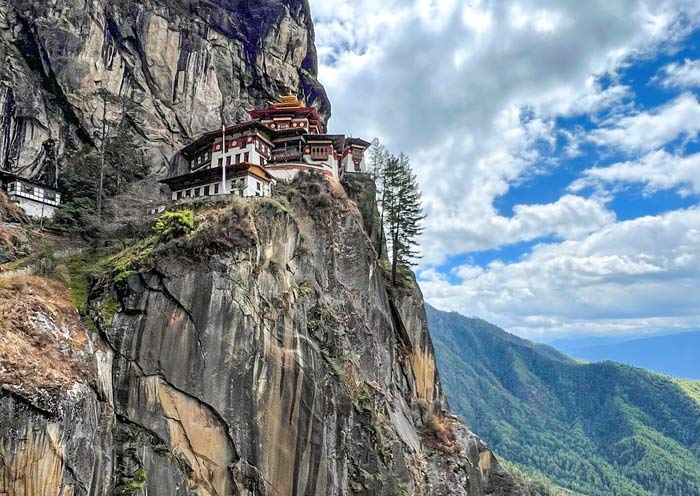
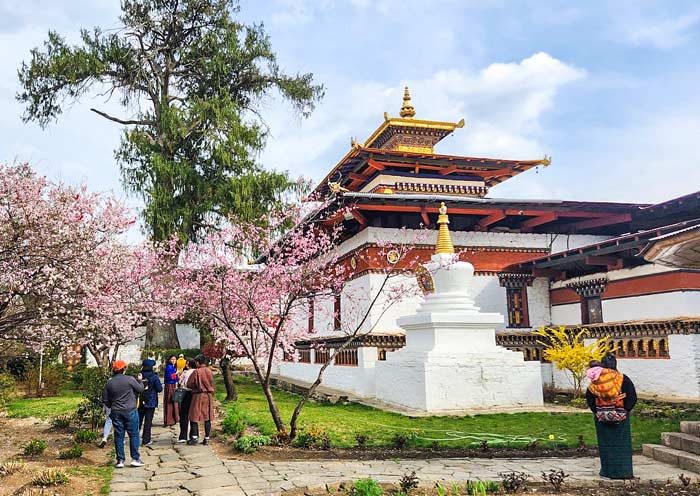
Happiness is a place, wish you had get your happiness philosophy from the beautiful Himalayan country with us. It is time to end your 12-day India Bhutan Tour. Your guide will escorts you to Paro International Airport for your flight to your next destination.
Extension Ideas: If you prefer to travel longer in Bhutan, you can extend your trip to other highlighted parts of Bhutan, including Haa, Gangtey, and Bumthang.
Thank you for choosing Asia Odyssey Travel (AOT) for your Bhutan tour, and we are always here working for you and hope to see you again for your next trip to Asia. Safe journey!
Note:
Please note that some of the sites mentioned in the itinerary may be subject to change based on factors such as the season, weather conditions, national holidays, and special events. We reserve the right to modify the itinerary to ensure an enhanced tour experience in Bhutan.
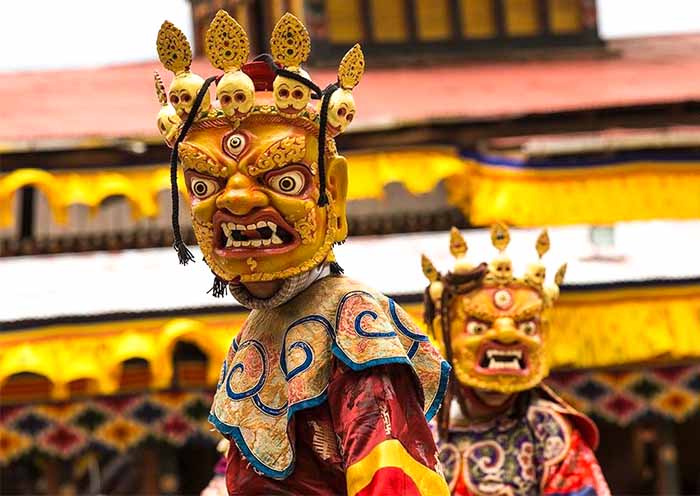
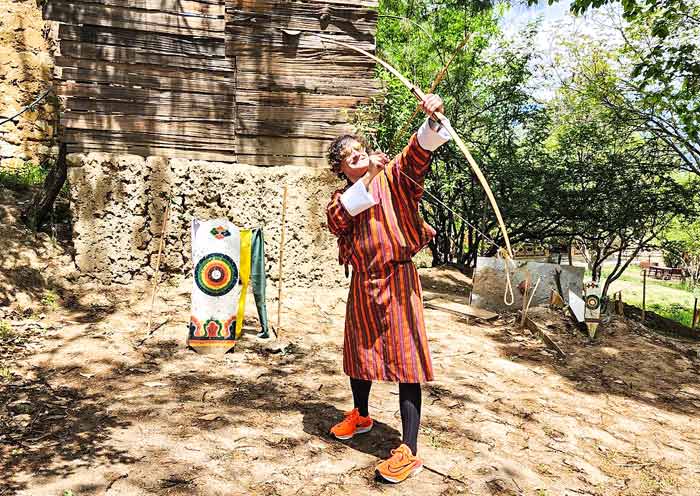
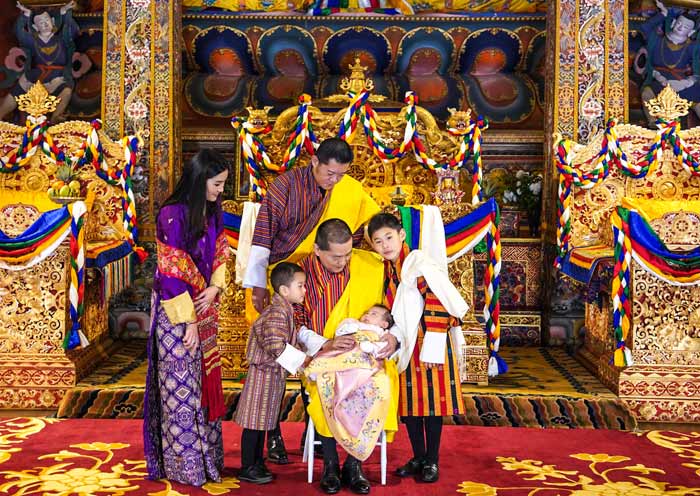
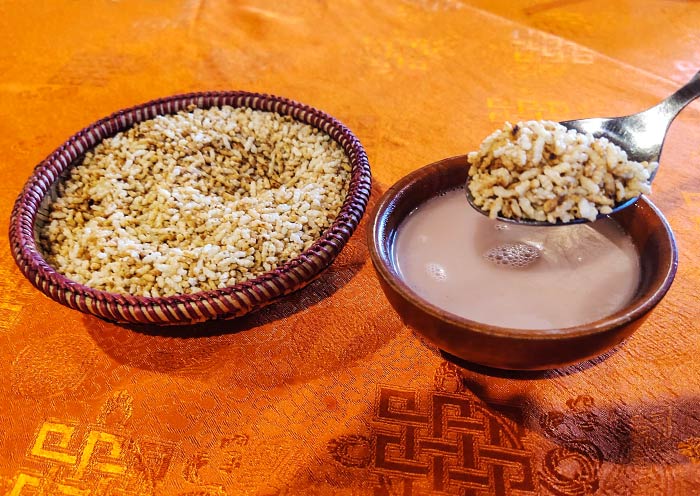
Price: What’s Included & What’s Excluded
What’s Included?
What’s Excluded?
Important Trip Notes for Booking a Private Tibet Tour
All foreign travelers are advised to make their bookings at least one week in advance and send the necessary documents to us for obtaining the permits. However, if you plan to visit Mount Kailash, it is recommended to book at least two weeks in advance, as it may take longer to obtain the necessary permits.
Accommodation & Hotel Condition for Your Tibet Tour
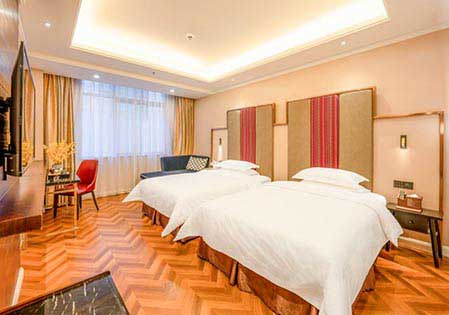
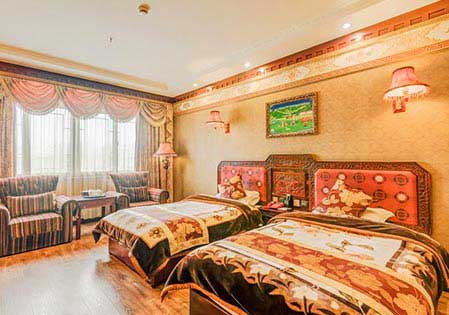
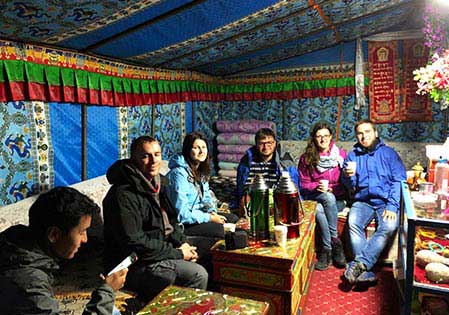
Have a good sleep everyday is very important during your China tour. In a private tour, you can decide on your own which hotel class you want - luxury 5 star, comfortable 4-star or economic 3-star.
All the hotels in each destination we selected are at good location, close to commercial street or tourist attractions. And, all the hotels we use have a business relationship for many years and they have windows, air-conditioners, hot water, showers, wifi... (except for basic accommodation condition when travel to Mount Everest) to ensure you luxury and comfortable sleep experience. The staff can speak English and they will provide you the high quality service. If you have any requirements, you can ask them to help.
Photo Gallery for This Itinerary
Latest Himalaya Tours Reviews from Our Customers

cindy heng
Malaysia
Date of Experience: Sep 07, 2025
Tour Customized by: Abby
You May be Interested in This Tour: Customized Tour

mui m
Vietnam
Highly recommend Asia Odyssey - they planned a fantastic itinerary against our brief for Tibet, Nepal, and Bhutan. Special shoutout to Ms. Mandy who planned our trip, answered all our questions, was incredibly responsive, and was always helpful. She checked in during our trip to make sure we were okay as well. On our trip, our local guides were knowledgeable and kind and our accommodation was comfortable. All-in-all a fantastic experience and highly recommended.
Thank you for a wonderful experience!!
Destination(s): Tibet
Date of Experience: Jun 05, 2025
Tour Customized by: Mandy
You May be Interested in This Tour: Customized Tour

Bhawani Thangaratnam
Malaysia
Date of Experience: Aug 31, 2025
Tour Customized by: Steven
You May be Interested in This Tour: Customized Tour
Price: Request
(Based on a private tour for two people. Price varies depending on program, travel date, number of people.)
Free Enquiry! You don’t need to pay for the reservation.
- United States (+1)
- Australia (+61)
- Singapore (+65)
- Malaysia (+60)
- Philippines (+63)
- Canada (+1)
- Italy (+39)
- Indonesia (+62)
- United Kingdom (+44)
- Spain (+34)
- Mexico (+52)
- Hong Kong (+852)
- Thailand (+66)
- United Arab Emirates (+971)
- New Zealand (+64)
- South Africa (+27)
- Germany (+49)
- Brazil (+55)
- India (+91)
- France (+33)
- Vietnam (+84)
- The Netherlands (+31)
- Saudi Arabia (+966)
- Ireland (+353)
- Argentina (+54)
- Switzerland (+41)
- Romania (+40)
- Pakistan (+92)
- Japan (+81)
- Portugal (+351)
- Bangladesh (+880)
- South Korea (+82)
- Puerto Rico (+1)
- Türkiye (+90)
- China (+86)
- Belgium (+32)
- Qatar (+974)
- Greece (+30)
- Taiwan (+886)
- Austria (+43)
- Poland (+48)
- Israel (+972)
- Chile (+56)
- Sri Lanka (+94)
- Nigeria (+234)
- Peru (+51)
- Colombia (+57)
- Hungary (+36)
- Nepal (+977)
- Denmark (+45)
- Bulgaria (+359)
- Norway (+47)
- Slovenia (+383)
- Sweden (+46)
- Kuwait (+965)
- Costa Rica (+506)
- Ecuador (+593)
- Venezuela (+58)
- Malta (+356)
- Croatia (+385)
- Tunisia (+216)
- Czechia (+420)
- Mongolia (+976)
- Bahrain (+973)
- Mauritius (+230)
- Papua New Guinea (+675)
- Cambodia (+855)
- Dominican Republic (+1)
- Luxembourg (+352)
- Finland (+358)
- Guatemala (+502)
- Myanmar (+95)
- Maldives (+960)
- Slovakia (+421)
- Laos (+856)
- Serbia (+381)
- Brunei (+673)
- Oman (+968)
- Macao (+853)
- Panama (+507)
- Morocco (+212)
- Jordan (+962)
- Georgia (+995)
- Fiji (+679)
- Bolivia (+591)
- Lithuania (+370)
- Bahamas (+1)
- Cyprus (+357)
- Latvia (+371)
- Bhutan (+975)
- Iraq (+964)
- Iran (+98)
- Kenya (+254)
- Jamaica (+1)
- Zimbabwe (+263)
- Azerbaijan (+994)
- Uruguay (+598)
- Estonia (+372)
- Andorra (+376)
- Cameroon (+237)
- Ghana (+233)
- Kazakhstan (+7)
- Nicaragua (+505)
- Egypt (+20)
- Russia (+7)
- Albania (+355)
- Réunion (+262)
- Montenegro (+382)
- Algeria (+213)
- Afghanistan (+93)
- Martinique (+596)
- Uganda (+256)
- Honduras (+504)
- North Macedonia (+389)
- Trinidad and Tobago (+1)
- Suriname (+597)
- Antigua and Barbuda (+1)
- Zambia (+260)
- Ukraine (+380)
- Armenia (+374)
- Barbados (+1)
- Belarus (+375)
- Palestine (+970)
- Lesotho (+266)
- Moldova (+373)
- Ethiopia (+251)
- French Polynesia (+689)
- Gambia (+220)
- Guam (+1)
- Gibraltar (+350)
- Isle of Man (+44)
- New Caledonia (+687)
- El Salvador (+503)
- Comoros (+269)
- Seychelles (+248)
- Chad (+235)
- Samoa (+685)
- Cook Islands (+682)
- Palau (+680)
- Paraguay (+595)
- DR Congo (+243)
- Solomon Islands (+677)

